Category: reviews
Portable oxygen concentrators are medical devices used to treat conditions where people can’t get enough oxygen from the air, breathing on their own. Take a look at our top picks of the best portable oxygen concentrators available on the market and make an informed decision!
Portable oxygen concentrators act as medical devices intended for people with medical conditions that compromise their natural ability to take in adequate oxygen from the atmosphere. Usually, these health problems limit the lungs’ capacity to absorb enough oxygen from the air, making it essential to provide an additional source of oxygen for the patient to preserve normal functioning. Such devices are commonly needed for conditions like:
- Asthma
- Chronic obstructive pulmonary disease (COPD)
- Pneumonia
- Sleep apnea
- Cystic fibrosis
- Chronic bronchitis
- Congestive heart failure
- Bronchopulmonary dysplasia (BPD)
- Emphysema
- Other lung diseases
In this article, you will find a detailed list of the best portable oxygen concentrators currently sold on the market, how they work, what type of oxygen concentrators exist, and answers to some common questions people have on this topic. You should know that these devices can only be obtained only through a doctor’s prescription. In order for your physician to determine whether or not you need a portable oxygen concentrator, he or she will run a series of tests and prescribe you the corresponding therapy. Our review are carefully created to help you make an informed decision.
How Do Portable Concentrators Work?
Air contains around 78% of nitrogen, 21% of oxygen and 1% of other gasses. Portable oxygen concentrator draws in the air and compresses it while the cooling mechanism keeps it from overheating. The concentrators contain zeolite materials that can adsorb nitrogen at a much higher rate than oxygen. The nitrogen stays while the oxygen passes through a component called molecular sieve to the breathing apparatus, which is usually in the form of nasal tubing or facial mask. The air delivered to the patient usually contains between 87% and 96% oxygen.
There are two methods of delivering air – continuous flow, which continually provides oxygen regardless of the user’s breathing rate; and intermittent or pulse flow, which only gives oxygen when the user is inhaling. While pulse flow option conserves oxygen, it is not recommended for those who need oxygen concentrator while sleeping, as some people might not inhale hard enough to trigger the pulse. Most concentrators have one or the other method, but some models have both.
Continuous flow portable oxygen concentrators deliver up to 3000 mL of oxygen per minute. They are usually heavier than pulse flow units and weigh around 10 to 20 pounds. They are recommended for use when sleeping or sitting still.
Pulse flow portable oxygen concentrators deliver between 450 mL and 1250 mL of oxygen per minute, based on the user’s breathing rate. They weigh 2 to 10 pounds and are recommended for the more active users.
Stationary vs. Portable Concentrators
When you think about oxygen therapy, the first thing that comes to mind are those huge oxygen tanks. Science has come a long way since the introduction of pressurized oxygen tanks in the 1970s, and the portable concentrators are a great option today for people who lead an active lifestyle.
The most apparent disadvantage of oxygen tanks is that they are relatively big and heavy, so you can’t go anywhere you want with them. They are usually installed in the house and come with very long tubes so that you can walk around the house and still get sufficient oxygen. Another downside is that when they run out of oxygen, they need to be replaced or refilled, and patients had to pay medical care suppliers for each visit, which was very cost ineffective.
When first introduced, oxygen concentrators were stationary, tall and heavy. The portable concentrators first appeared in the early 2000s, to help patients get the needed therapy when away from home.
In this table, we listed the advantages and disadvantages of portable concentrators compared to pressurized oxygen tanks.
| DELIVERY SYSTEM | PRESSURIZED OXYGEN TANKS | PORTABLE OXYGEN CONCENTRATORS |
| Height | 5” to 52” | 7” to 20” |
| Weight | 1 to 114 lbs. | 3 to 20 lbs. |
| Average operating time (Continuous Flow) | 2 to 11 hours (lowest LPM setting)
20 minutes to 2 hours (highest LPM setting) |
2.5 to 6 hours (lowest LPM setting)
45 minutes to 1.5 hours (highest LPM setting) |
| Average operating time (Pulse flow) | 5 to 30+ hours (lowest LPM setting)
1 to 6 hours (highest LPM setting) |
4 to 10+ hours (lowest LPM flow)
1.5 to 4 hours (highest LPM flow) |
| Oxygen storage | Limited; suppliers must replenish oxygen supply regularly | Unlimited; they don’t need to be replaced as long as they are working correctly |
| Power source | None; stored oxygen is delivered, and there is no need for electrical or battery power | Electrical outlet and 1 to 2 batteries |
| Humidifier | External | Built-in |
Portable oxygen concentrators are mobile and provide access to a continuous supply of oxygen without the need to replace or refill the tanks. However, their disadvantage is the operating time, but it is not a severe problem as everybody has access to a power outlet.
Most Common Questions When Buying A Portable Oxygen Concentrator
If you have one of the conditions that require oxygen therapy, I’m sure you have a lot of questions about getting the best possible portable oxygen concentrator. We’ll try to answer them all.
- Are portable oxygen concentrators dangerous?
Oxygen is highly flammable, so the usage of this device poses a fire risk. That’s why you shouldn’t smoke when you use them and shouldn’t be close to open flames. Also, they shouldn’t be used in small unventilated rooms. - What is the price of portable oxygen concentrators?
The price varies between $2000 and $4000, depending on the model. You can also rent one for a monthly rate of $200 to $350. - Does my insurance cover the price of portable oxygen concentrator?
In most cases, the answer is yes, but you should check with your insurance provider. - How much air does portable concentrator deliver?
It depends on the model and setting, but it’s usually between 0.5 to 3 liters per minute. - What is the oxygen purity of the delivered air?
Most of the concentrators deliver the air that contains between 87% and 96% of oxygen. - What is the size of portable oxygen concentrators?
They are usually small and lightweight, so you can always put them on a bedside table. Taller models can be placed on the floor next to the bed. - How many batteries does a concentrator need?
One or two depending on the model. - What is the operating time of a portable concentrator?
Generally, the higher settings drain the battery faster than the lower settings. On average, during continuous flow, it will deliver oxygen for 2 hours on the highest setting, and up to 6 hours on the low settings. When on pulse flow, the battery will usually last 2 hours on the high and 9 hours on low settings. - How long does it take to charge the batteries?
Usually, it takes 2 to 4 hours, but some can take up to 8 hours. - How loud is the concentrator?
Depending on the model and the settings they can make a noise of 65 dBA, which is the volume of a normal conversation. - Can I take my concentrator on a plane?
They are designed for air travel, and most portable concentrators can be transported at up to 14,000 feet. - How do I store my portable concentrator?
The portable concentrators should only be used and stored in specific ranges of temperature and humidity, and both ranges are in the product’s manual. - How do I maintain my portable concentrator?
The portable concentrators are easy to use, and they need weekly maintenance. You’ll usually need to wash it with a damp cloth and gentle detergent or inspect the tubes to make sure that everything is alright, but the exact instructions are always in the product’s manual. Also, don’t use it until it is completely dry. - Does my concentrator have a product warranty?
Yes, most of them have a warranty of 3 to 5 years. Specific components, such as molecular sieve or batteries can have a separate warranty that can last anywhere from 1 to 5 years. - Do I need a portable oxygen concentrator?
If you suspect that you have trouble breathing, you should pay a visit to your doctor who will run a series of tests and determine if you need oxygen therapy. Doctors will give you all the information you need.
Best Portable Oxygen Concentrator Brands And Models
We have gathered user reviews and made a list of the best portable oxygen concentrators. Here are the prices and specifications of our top five models.
| BRAND | SEQUAL | INOGEN ONE | RESMED | RESPIRONICS | OXLIFE INDEPENDENCE |
| Model | eQuinox (24-cell battery) | G3 (16-cell battery) | LifeChoice Active Ox 4L | SimplyGo Mini (extended battery) | O2 |
| Size (HxLxW) | 13.6 x 10.6 x 7.4 | 8.3 x 8.8 x 3 | 7.9 x 9 x 4.4 | 10.2 x 8.3 x 2.6 | 20.2 x 10.9 x 8 |
| Weight | 16 lbs. | 5.8 lbs. | 4.8 lbs. | 6 lbs. | 18 lbs. |
| Oxygen Purity | 90% ± 3% | 90% ± 3% | 90% ± 3% | 87% to 96% | 87% to 95.6 % |
| LPM Range (Continuous) | 0.5 to 3 | No continuous flow setting | No continuous flow setting | No continuous flow setting | 0.5 to 3 |
| LPM Range (Pulse) | 1 to 9 | 1 to 5 | 1 to 4 | 1 to 6 | 1 to 6 |
| Number of Batteries | 1 | 2 | 1 | 1 | 1 or 2 |
| Battery Life (Continuous) | 4.84 hours (1)
2.75 hours (2) 1.83 hours (3) |
N/A | N/A | N/A | 5.75 hours (0.5)
5.25 hours (1) 3.5 hours (1.5) 2.5 hours (2) 2 hours (2.5) 1.5 hours (3) |
| Battery Life (Pulse) | 5.94 hours (1)
5.39 hours (3) 3.85 hours (6) |
9.5 hours (1)
8.5 hours (2) 6 hours (3) 4 hours (4) 3.3 hours (5) |
10.25 hours (1)
8.25 hours (2) 5 hours (3) 4 hours (4) |
9 hours (1-2)
5 hours (3) 4 hours (4) 3 hours (5) |
6.25 hours (0.5)
6 hours (1-1.5) 5.75 hours (2) 4.75 hours (2.5) 4 hours (3) 3.5 hours (3.5) 3 hours (4) 2.5 hours (4.5) 2.25 hours (5) 2 hours (5.5) 1.75 hours (6) |
| Battery Recharge Time | 1.5 to 3.5 hours | 9 hours (2 batteries) | 2 to 4 hours | 4 to 8 hours | 1.5 hours (1 battery)
2.5 hours (2 batteries) |
| Noise | 37 to 46 dBA | 55 to 65 dBA | 41 to 48 dBA | 43 dBA (2) | 40 dBA (2) |
| Maximal Altitude | Not disclosed | 10,000 ft. | 13,000 ft. | 10,000 ft. | 13,123 ft. |
| FAA Approved? | Yes | Yes | Yes | Yes | Yes |
| Operating Temperature | 50ᵒF to 104ᵒF (10ᵒC to 40ᵒC) | 41ᵒF to 104ᵒF (5ᵒC to 40ᵒC) | 40ᵒF to 105ᵒF (5ᵒC to 40ᵒC) | 41ᵒF to 95ᵒF (5ᵒC to 35ᵒC) | 50ᵒF to 104ᵒF (10ᵒC to 40ᵒC) |
| Storage Temperature | Not disclosed | -13°F to 158°F (-25°C to 70°C) |
30°F to 140°F (0°C to 60°C) |
-4°F to 140°F (-20°C to 60°C) |
-4°F to 140°F (-20°C to 60°C) |
| Operating/ Storage Humidity Range | Not disclosed | 0% to 95% | 15% to 93% | 15% to 93% | 0% to 95% |
| Warranty | Device: 3 years | Device: 3 years | Device: 3 years
Sieve: 3 years Battery: 3 years |
Device: 3 years
Sieve: 1 year Battery: 1 year |
Device: 5 years
Battery: 1 year |
| Price | $4,050 | $2,665 | $2,295 | $2,795 | $2,450 |
We have given you an objective review of the best portable oxygen concentrators on the market. Be sure to check with your doctor, and pick the one that is best suited to the therapy they prescribed.
Bunk beds are an excellent and space-saving way for parents with more than one child. Not only you gain an extra bed’s worth of space in a given room, but you also get additional storage compartments and functionalities.
For those living in tight quarters with multiple children, bunk beds are an excellent solution for utilizing space efficiently. These pieces not only help in conserving floor area but also often come equipped with additional storage and amenities akin to those in high-end office desks. However, the cost of bunk beds can be on the higher side, emphasizing the importance of a well-thought-out and researched acquisition. It’s imperative that this furniture investment stands the test of time, remaining a central feature of the room. This guide is designed to navigate you through the process of finding the ideal bunk bed, especially useful for those unsure of where to begin their journey. We’re here to narrow down your choices to the best quality bunk beds available.
Our Top Picks
Walker Edison Furniture Full Metal Loft Bed
This bed outperforms almost everything else available to students. Most dorm room furniture purchases end up in the garbage disposal within a month or two, but this model is made of powder-coated steel and sturdy enough to last for years. Its two ladders let you freely position the bed anywhere in the room without worrying about angle or contact with other furniture.
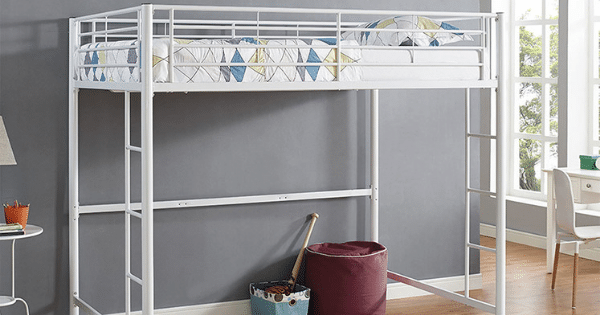
One of the most significant selling points when it comes to this bed is the sheer amount of space it gives you underneath the mattress and it is incredibly useful for storage and makes this bed an excellent choice for kids since it lets them play in that area. Kids like to make “houses” with this kind of setup, so the Walker Edison Furniture model lets them express their creativity. On the other hand, if you’re a student sharing your living space with roommates, this model gives you enough space for a small office under the mattress.
While the bed is pretty sturdy and backed with a 30-night warranty, complications may arise. Thankfully, you have the option of requesting replacement parts to fix any issue you run into, and the product ships with detailed assembly instructions. Couple that with this bed’s affordable, student-friendly price, and you have a really good value pick.
Selling Points:
- Affordable for students and most families
- Lots of space under the mattress for storage or various activities
- Easily obtainable spare parts
Dorel Living Sierra Triple Bunk Bed
This solid wood bunk bed is highly adaptable to various room layouts and sleeping habits. The fact that you can separate all three beds lets people position anywhere in the room that makes sense for them, such as near windows, away from restless sleepers, etc. The Dorel Living Sierra model is sturdy enough to support three fully grown adults, although it’s most frequently used for children. Each bed is made to support a twin-size mattress, and in such a scenario, the warranty for this model lasts one full year.
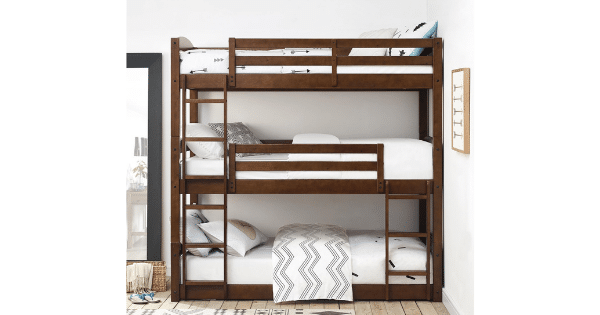
Triple bunk beds can present parents with safety considerations. As a response to those worries, this bed has incredibly sturdy guardrails and ladders that enable easy access to the upper two bunks. If you separate the beds, you can also store various supplies under them, giving you even more space in the room.
This model is incredibly easy to set up, even with only one person doing the work. Couple that with the super-affordable price and you have a perfect choice for parents in a pinch, or anyone else needing to accommodate multiple people. Make sure to measure your room height before investing; it’s generally good practice for planning new furniture investments.
Selling Points:
- Low price
- Durable and sturdy
- Very safe
- Easy to assemble
Zinus Hani Steel Quick Lock Bunk Bed
The main selling point here is in the name – the Quick-Lock system makes it laughably easy to assemble this bed, even if you have zero previous technical experience. Not only that, but you can order expert assembly on the spot if you place an order on Amazon. Because Zinus Hani Bunk Bed is made entirely out of steel, it’s quite sturdy. A 5-year warranty backs the product, and the Quick-Lock system makes it easy to slot in any replacement parts you obtain.
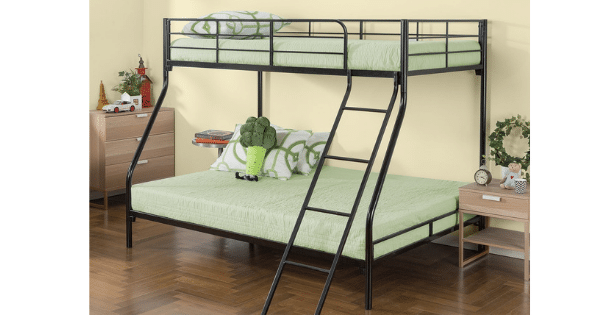
Both bunks are created to support someone at or under 175 lbs. Although the guardrails are sturdy, it’s considered a safety risk to allow a child under six years onto the top bunk without supervision. The ladder is locked into place, so it’s hard to feel even remotely unstable while climbing. The instructions for assembly are intuitive and easy to understand if you would rather put the thing together yourself. If you can find your way through the instructions, it only really takes one person an hour to complete the full assembly. The price point is very generous for what you get, and the overall construction has an elegant shape that could bring a room to life.
Selling Points:
- Easily assembled by just one person
- Durable and sturdy
- 5-year warranty
- Low price
Max & Lily Full-Over-Full Bunk Bed With Trundle Bed
With a solid wood construction made from the finest knot-free New Zealand pine, this Max & Lily full-over-full bunk bed stands out immediately on touch. A lot of lower-quality beds use metal-on-wood connections, which essentially puts the wood part on a timer, and risks your bed’s structural safety and integrity. This bed uses metal-on-metal, however, so there’s no such risk. It is a very hardy model and supports people up to 400 lbs with full-sized mattresses. The Trundle bed can be easily repurposed for storage if necessary, and the bunks can be separated for extra flexibility.
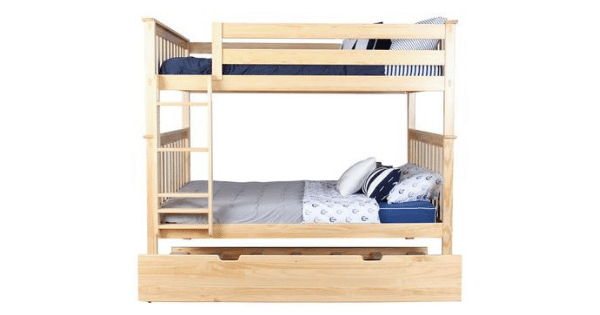
The 14-inch guardrails do their job and keep the bunks safe even for small kids, as long as your mattress is of a conventional size. The ladder has rounded edges to minimize any risk of injury or discomfort, which makes it fun for children to navigate and helps parents convince their kid to go to sleep on their own finally.
The customer service is top-notch. This model isn’t the easiest bed to set up, but that’s made up for by how useful and understanding the customer support representatives are.
Selling Points:
- High-quality wood construction
- Excellent customer support
- Safe for kids
- Flexibility from separating the beds.
- Good storage space
DHP Twin-Over-Twin Bunk Bed
Another classic quality model, this DHP bunk bed is also pretty affordable. The full-metal construction offers improved durability over time, so the bed almost always vastly outlives its 1-year warranty. The top bunk supports 200 lbs of weight, while the bottom one can support 225 lbs. It is typically enough for most small-average sized adults, which means kids have no issues whatsoever. The ladder for the top bunk is slanted, which has been proven to be safer for people of all ages.
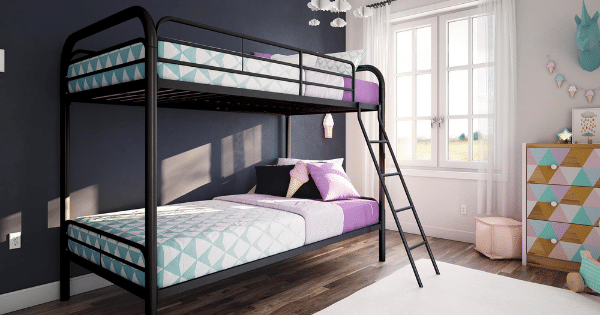
Both beds feature narrow slats that are capable of accommodating virtually any mattress you can find. In terms of assembly, this bed isn’t the easiest to set up. It is mostly because there are over a hundred individual components. Thankfully, every part is clearly labeled, and the instructions are quality, so it shouldn’t take a single person more than three hours. We suggest having someone help you assemble this bunk bed, as that cuts down the time significantly and you can help each other accurately and firmly fasten parts together. You also may want help to transport the single box package, as it’s rather heavy. Once you’re safely done with the assembly, you’ll why this product is one of the best.
Selling Points:
- Sturdy
- Long-lasting
- Great instructions for assembly
Stephan Full-Over-Full Bunk Bed
If you wanted nothing but durability and longevity, this model is your best friend. The heavy and robust thick steel frame prevents not only structural problems but also any kind of shaking or rattling. The sheer weight and stability of this frame can support a larger than average weight, with each bunk clocking in at 400 lbs. of support. The gunmetal finish is sure to make Stephan Full-Over-Full Bunk Bed a centerpiece of any room it’s in, and it feels nice to the touch, which can sometimes make the difference between quickly relaxing and struggling to fall asleep.
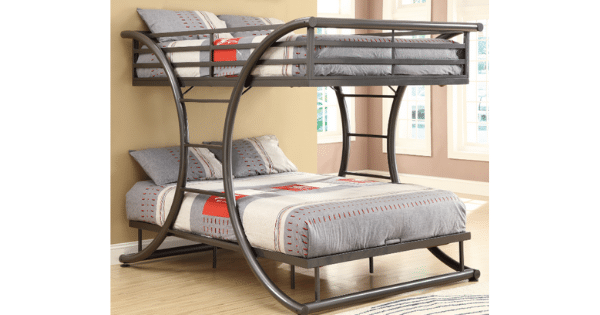
Both sides of this bunk bed setup feature ladders, allowing for easy access and ease of positioning in a room. There is an above average amount of space under the lower bunk, helping you squeeze more storage space out of your room. The guarantee lasts a staggering ten years, far above most bunk beds on the market right now. If that doesn’t scream high value, we don’t know what will. The customer support is also very satisfying, with options to receive detailed instructions the second you call them.
Note: Make sure you get some help to unload this thing, as all that durability comes at the cost of extreme weight. The assembly isn’t very difficult, but moving the package into the room may be.
Selling Points:
- Absurdly durable and long-lasting
- Relatively easy to assemble
- Affordable
- Great customer support
Buyer’s Guide FAQ
We’ve set aside this section for answering several commonly-asked questions for our reading audience. If you’re considering investing in a bunk bed, here are some things you may want to ask yourself.
Which materials are bunk beds made of?
The most common options you will see are plastic, hardwood, softwood, and metal. The main difference is durability and price.
Plastic bunk beds, for example, often cost very little. It is helpful for new parents as these beds are made almost entirely for very young children, and it lets those parents allocate their budget more freely. However, once the weight starts coming in, plastic bunk beds can become a real safety risk, as they’re the least durable overall.
Metal bunk beds tend to sport high durability and can usually support slightly above average weight. It is one of the most common materials you’ll run into, and they’re a fine purchase.
Softwood is less durable than hardwood or metal but is fairly affordable and more comfortable than most metal bunk beds.
Hardwood is the high-budget option, for sure. It’s the most sturdy and reliable, often the best looking and feels very good to the touch, but these beds often cost a lot. If you can afford them, they’re almost unquestionably the best bunk beds out there.
How do I know whether a bed will support someone’s weight?
Seemingly an obvious question, but there’s a caveat most people don’t acknowledge on time, and this creates massive complications, in the long run, even damaging otherwise great beds. Never forget that the mattress itself counts towards the supported weight limit. The weight support is an attribute of the slats, not the mattress or overall bed frame. If you go slightly overboard with huge mattresses, the bed becomes unusable for more people due to its weight limit. If you’re unsure, consult a sales representative and let him know what kind of mattress you plan on using – they should immediately be able to point you towards beds that can support it.
Are there any safety tips people should keep in mind?
Always. Here’s a list:
- Never let your kids wrestle or jump around on bunk beds.
- Do not let very young children sleep on anything except the bottom bunk. Most injuries in situations with bunk beds happen to young kids through falling.
- Always measure the room before purchasing any bunk bed. The ceiling can pose a problem for the top bunk sleeper.
- Don’t let anyone sleep on the top bunk if the guardrail is detached, damaged or otherwise compromised. Falling from that kind of height is no joke, even for fully grown adults.
- Don’t position the bed in a way that puts the top bunk near a ceiling fixture, especially if it includes a ceiling fan.
- Don’t buy used bunk beds. It may save money, but there are safety risks involved that may lead to not just financial expenses, but serious injuries.
For most households buying a mattress is a serious financial investment, and if you want to get the best mattress that fits your budget, our buying guide can help.
Deciding to invest in a new mattress is not an easy decision, especially considering that the cost for a Queen-size mattress can range from $1000 to $2000. While it’s possible to find mattresses priced as low as $150, their quality and performance often do not compare to more expensive models. For most households, this purchase is a considerable financial investment. Although many mattresses come with sleep trials and warranties, the hassle of returning a mattress and getting your money back is something you’d likely prefer to avoid. When comparing mattresses based on their prices, it’s crucial to take into account several aspects to ensure you make a well-informed decision, such as the mattress’s longevity, its ability to relieve pressure, isolate motion and noise, and regulate temperature.
To ensure you choose the right mattress for the below-average price, we have created a short guide which contains useful strategies for first-time mattress buyers. In this list, we have selected best-value mattresses available in three different price ranges – less than $600, $1000 and $1500. This price refers exclusively to Queen-size models or smaller. To create this list, we have consulted five sleep experts, considered more than 150 mattresses and spent 120 hours researching.
The Allswell – Best Mattress under $600
HIGHLIGHTS: Medium firmness, excellent edge support, sleeps cool, 100-night sleep trial and a 10-year warranty
Quality beds prices less than $600 are pretty much rare. However, the Allswell innerspring bed is a notable exception. This mattress is affordable to every budget and has all the qualities its pricier competitors have to offer, such as quality support, excellent responsiveness, and temperature neutrality.
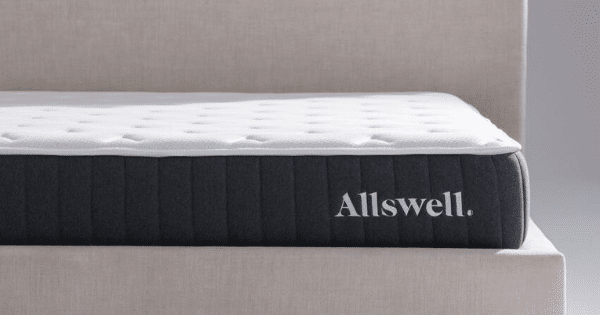
When it comes to conforming and pressure relief, this model really stands out. The mattress’s comfort layer is made from polyfoam and soft gel memory foam. You may think that this mattress is noisy, but unlike most innerspring models, it produces significantly less noise than its pricier competitors. The Allswell has excellent airflow that ensures the sleeper always sleeps cool. Lastly, the product is backed up with a 100-night sleep trial and a 10-year warranty, which are both significantly longer than average for mattresses in that price range.
Recommended for:
- Back and stomach sleepers
- Average or heavyweight sleepers
- Back pain sufferers
- Hot sleepers
Tuft & Needle – Best Mattress Under $600
HIGHLIGHTS: Medium firmness, excellent conforming and pressure relief, quality motion isolation, 100-night sleep trial, and a 10-year warranty
The Tuft & Needle mattress is low priced for its qualities. It’s an all-polyfoam bed with three comfort layers, and medium firm feel. The surface is excellent for average weight sleepers and those who prefer to sleep on their back or side. High-density foam base ensures close conforming and higher quality edge support that standard all-foam models.
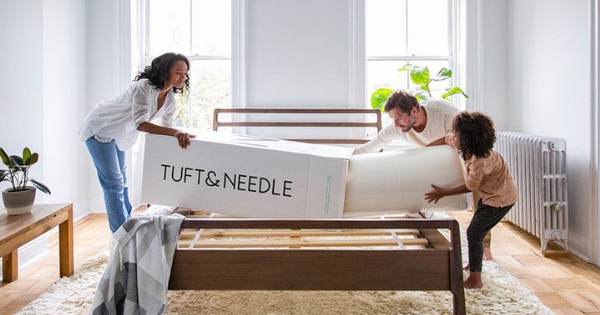
When it comes to motion isolation, the mattress doesn’t make any noise when bearing weight and its perfect for couples. Temperature neutrality is also better than average and the top foam layers infused with cooling gel and charcoal will definitely help you sleep cool through most of the night.
Recommended for:
- All sleep positions
- All weight groups
- Couples
- Hot sleepers
Layla – Best Mattress under $1,000
HIGHLIGHTS: Flippable with dual firmness, excellent motion isolation, close contouring and pressure relief, 120-night sleep trial and a lifetime warranty
The Layla mattress stands out for several reasons. One of the most notable reasons is that Layla is a flappable mattress with dual firmness. One side is medium soft, while the other is considered firm. Due to its unique design and dual firmness, the model is suitable for all weight groups and sleepers with various firmness preferences. The mattress is very light, so the users can easily flip it when needed.
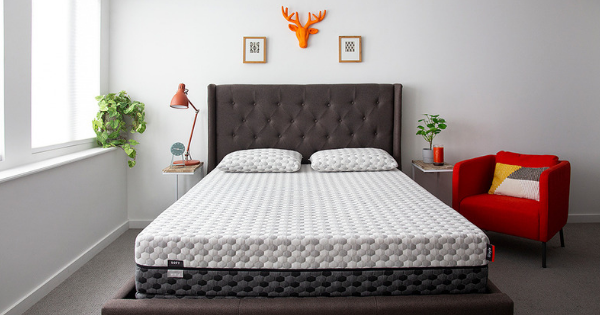
The model contains copper-infused memory foam which provides excellent conforming and pressure relief. It’s particularly beneficial to side sleepers because it ensures their spine is properly aligned during the entire night. The copper-infused memory foam also aids sleepers with poor circulation. Lastly, the softer side has another layer of convoluted polyfoam for additional cushioning, which helps maintain an even surface on both sides of the bed.
Recommended for:
- Side and back sleepers
- All weight groups
- People with poor circulation
Nectar – Best Mattress under $1,000
HIGHLIGHTS: Medium firmness, excellent contouring, and pressure relief, sleeps cool, 1-year sleep trial and a lifetime warranty
The Nectar Sleep mattress is thicker than average, but its multiple layers of memory foam ensure a comfortable and pressure relieving experience for most sleepers. Compared to other memory foam beds, Nectar is priced significantly lower.
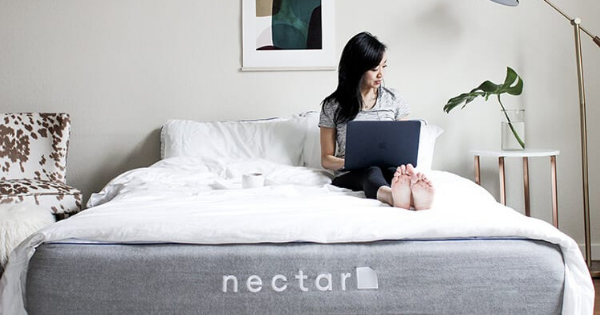
The comfort system of the bed consists of gel memory foam and standard memory foam. It is most suitable for sleepers of average weight. The dual-layer support core reinforces the mattress and ensures the sleepers don’t sink, even if they prefer to sleep closer to the edges. Additionally, Nectar comes with a cotton-lyocell cover for cool sleep. As its price and qualities aren’t enough, the Nectar mattress comes with one of the longest sleep trials and warranties available anywhere in the world.
Recommended for:
- All sleep positions
- Average and heavyweight sleepers
- Back pain sufferers
- Hot sleepers
Loom & Leaf – Best Mattress Under $1,500
HIGHLIGHTS: Multiple firmness options, Excellent conforming and motion isolation, 120-night sleep trial and 15-year warranty, free White Glove delivery
The Loom & Leaf by Saatva offers better support, pressure relief, and temperature neutrality than many of its higher-priced competitors. The Loom & Leaf consists of standard memory foam comfort layers and gel memory foam which apart from providing close contouring and excellent pressure relief, also ensure the sleeper stays cool during the entire night.
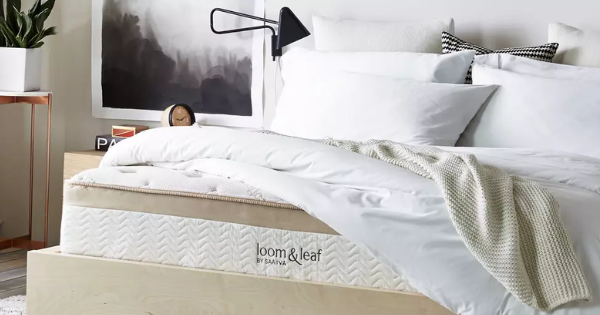
Since the model comes with two firmness options, it is suitable for most sleepers regardless of their weight and sleep position. The thick support core made of high-density polyfoam provides quality support while the thermogel infusion in the top layer, along with the breathable organic cotton cover ensures exceptional temperature neutrality and cool sleep.
Recommended for:
- Side and back sleepers
- All weight groups
- Pregnant women
- Couples
- Hot Sleepers
DreamCloud – Best Mattress Under $1,500
HIGHLIGHTS: Medium firmness, excellent conforming and pressure relief, quality motions isolation, 1-year sleep trial, and a lifetime warranty
Hybrid mattresses satisfy the needs of most sleepers because of their good balance in terms of contouring, support, and temperature neutrality. Hybrid models are mostly on the pricier side, but not the DreamCloud. This model consists of three memory foam layers and one latex transitional layer for additional support. The bed is a medium firm which is ideal if you are looking for close contouring and quality pressure relief.
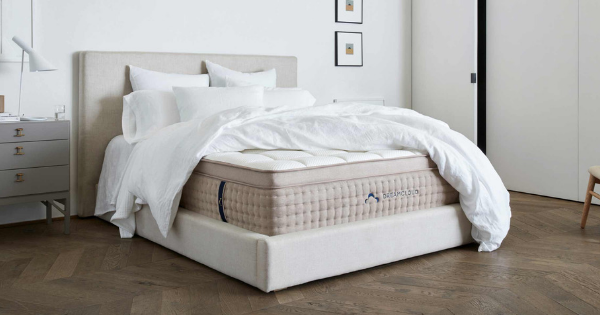
The mattress has a pocketed coil support core which ensures exceptional edge support and helps to maintain an even surface. Lastly, due to the strong airflow in the support core, the model is ideal for hot sleepers. Lastly, it comes with a significantly longer than average sleep trial and a customer satisfaction guarantee.
Recommended for:
- Back and side sleepers
- All weight groups
- Back pain sufferers
- Hot sleepers
Buyer’s Guide
As mentioned in the beginning, for most buyers, buying a new mattress is usually a significant financial investment. Quality mattress sold today are priced between $800 and $1,500, but high-end models may cost up to $5000 or even more. However, this doesn’t mean that you can’t get a high-quality and durable mattress at an affordable price. Let’s take a look at some of the most important considerations you should keep in mind when shopping for a new bed, as well as expected costs for different types.
Factors for Choosing an Affordable Mattress
One of the most crucial mattress construction and performance factors you should keep in mind are firmness, support, conforming, durability, edge support, motion isolation, temperature neutrality, responsiveness, and noise isolation. Let’s take a closer look at each of these factors.
Firmness: Firmness refers to how soft or firm the mattress feels to a sleeper. Some sleepers prefer sleeping on more rigid surfaces, while other prefer softer mattresses. In case you struggle with oscillating firmness preferences, you can opt for a flippable mattress with dual firmness options.
Support: Proper support is essential for preventing various pains and aches, especially when it comes to back pain, and hip pain. The level of support a mattress has depends on its support core – the components located beneath the comfort layer. Sleeping on a supportive bed is also essential for keeping your spine properly aligned during the night.
Conforming/Pressure Relief: Memory foam and latex beds are known for their exceptional contouring abilities. Quality conforming is important to alleviate pressure in the spine and other joints. Innerspring mattresses don’t conform as closely as other mattress types. If you struggle with pressure or pain, you must get a close-conforming mattress.
Durability: An average mattress must perform at least seven years optimally. Innersprings and memory foam models may deteriorate faster than other mattress types. Latex models and airbeds perform for eight years or longer if properly maintained.
Edge Support: Innersprings and hybrids tend to sag around the edges; therefore, most of them are reinforced with high-density polyfoam for extra support. Mattresses made from foam or latex are rarely reinforced, and their edge support is not particularly strong.
Motion Isolation: Foam and latex mattresses absorb movement making it great for couples or people generally sensitive to movement. Innersprings and hybrids, absorb and isolate motion significantly less.
Temperature Neutrality: Memory foam beds tend to trap heat which may be a problem for those who generally sleep hot. Innerspring mattresses usually sleep much cooler.
Responsiveness: Innerspring and hybrid models are bouncier and great for sex. Memory foam and latex mattresses respond slower, causing a sinking sensation that makes the couple feel like they are fighting the mattress.
Noise: Innersprings and hybrids are noisy due to their metal parts. Memory foam and latex mattresses are almost entirely silent when bearing weight.
Apart from these considerations, your body type, weight and sleep preference may help you determine which mattress is the best for you.
Mattress Types and Costs
The price-point of a mattress is generally linked to the mattress type. Innersprings and memory foam types are more affordable than latex mattresses, hybrid varieties, or airbed options.
Innerspring mattresses – have steel springs in their support core, and one to two layers of polyfoam in the comfort layer. Four types of coils are used in today’s innersprings – Bonnell coils, offset coils, continuous wire coils, and pocketed coils. The thicker the gauge, the longer the overall lifespan of the mattress. The price depends on the type of coils in the support core. Continuous wire coils and Bonnell coils are found in more affordable models, while pocketed and offset coils are found in high-end and more expensive models.
Memory foam mattresses – are a popular mattress choice in recent years among consumers all over the world. Memory foam models are very comfortable, conforms closely to the sleeper’s body and help achieve ideal spinal alignment, and pressure relief. The comfort layer must include one layer of standard or specialty memory foam, and may additionally include gel memory foam, polyfoam or copper-infused memory foam. The support core is made from high-density polyfoam. Foam density is definitely a cost factor with high-density memory foam being the priciest option.
Latex mattresses – can be made from natural latex or synthetic latex, which is made from petrochemicals. Latex mattresses are excellent for targeted pressure relief, making it similar to memory foam. These models are considered the most durable mattresses on the market, with an average lifespan of eight years. Price depends on the type of latex used to construct the bed. Natural latex is more expensive than synthetic latex, and when it comes to specific kinds of latex, Talalay is costlier than Dunlop latex.
Hybrids – consist of at least two layers of latex and/or memory foam in the comfort system and a coil-based support core usually pocketed coils. Many sleepers consider hybrids combine “the best of” the innersprings and foam or latex models. When it comes to price, models with multiple memory foam and/or latex layers are more expensive, as well as those that have a pillow top. Pillow tops are not always recommended because also associated with shorter lifespans and sleeping hot.
Airbeds – have individual air chambers in the support core. Most come with adjustable controls that allow the user to adjust the firmness of the bed. These models are rare and typically expensive, but they last at least eight years if properly maintained. The support core is made from at least two air chambers, and the comfort layer contains at least one layer of polyfoam, memory foam or latex. When it comes to the price, models with remote or smart-app controls are more expensive than those with manual controls. The number of air chambers in the support core also affects the price because a higher number of individual chambers provide better comfort and pressure relief.
Buckwheat pillows offer a wide range of benefits, including flexibility, close conforming, pressure and pain relief, temperature neutrality, and excellent air circulation. Take a look at our in-depth buckwheat pillow buying guide based on extensive research and analysis.
Originally gaining traction in Eastern Asia, buckwheat pillows have since garnered a following in the United States. These pillows are stuffed with the protective casings of buckwheat seeds, known as buckwheat hulls. The advantages of using buckwheat pillows include their ability to provide solid yet flexible support, perfectly contouring to the shape of one’s head, shoulders, and neck. This feature helps in maintaining correct spinal alignment, which may alleviate pain and minimize pressure points. Furthermore, buckwheat pillows are designed to facilitate airflow and sustain a consistent temperature, thereby improving the quality of sleep. One of the benefits of these pillows is their customizable loft; by either adding or taking away hulls, individuals can adjust the pillow’s thickness according to their liking. Typically covered in cotton or organic cotton, these pillows offer an eco-friendly option for consumers searching for a new pillow.
This article will give you the necessary information about buckwheat pillows. We will provide you with the characteristics and benefits of these pillows, and you can also see our top 4 choices for buckwheat pillows you can find on the market.
Top 4 Buckwheat Pillows:
- Sobakawa Buckwheat Pillow
- Zen Chi Organic Buckwheat Pillow
- Hullo
- ComfyComfy ComfySleep Buckwheat Pillow
Sobakawa Buckwheat Pillow
Qualities:
- Firm
- Variable sleep trial
- Non-adjustable loft
- Contouring support and comfort
- Freezer-friendly for extra coolness
The Sobakawa buckwheat pillow has a thin and soft cover made entirely from organic cotton. However, there is no zipper on this model, which means you cannot remove or add hulls to it. But not to worry, it has a good amount of hulls that will give you excellent pressure relief and conforming. With its molding quality, the pillow will help align the sleeper’s body in a very natural position. The model sleeps relatively cool, but if you want it even cooler you can put it in your freezer and get an extra-cold surface to sleep on.
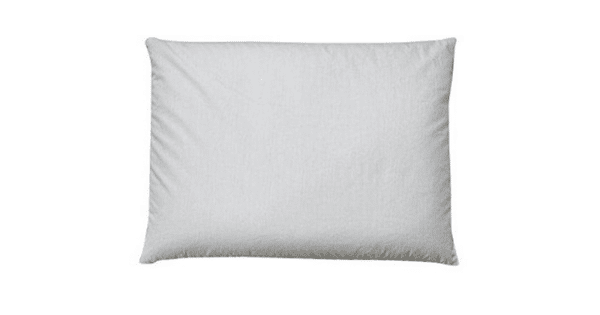
The price for buckwheat pillows is usually high, but the Sobakawa Buckwheat Pillow is an exception, and provides you the same pressure relief and conforming as any of the high-end models. This best pillow model is perfect for side and back sleepers in all weight groups (light, heavy, average) who prefer to sleep very cool and individuals that suffer from neck and shoulder pain. You can find it Queen and Standard sizes, and for the extra prices, you can get a cover.
Zen Chi Organic Buckwheat Pillow
Qualities:
- Firm
- 30-day sleep trial
- Adjustable loft
- Close conforming and pressure relief
- Sleeps very cool for most
The Zen Chi buckwheat pillow is made from entirely organic buckwheat hulls. No chemicals were used in the process making, and it won’t interfere with your sleep quality, and you can sleep safely. Because of the organic hulls, it also has good airflow, and you can sleep very cool. The pillow has excellent conforming and can help ease pain and aches in the areas of your shoulders and neck. The inner part of the pillowcase is made from very thin white cotton. It has a very convenient zipper which you can use to remove or add hulls. It is essential to remove the hulls when washing the pillow. The model is hefty, with its weight ranging from four to twelve pounds, depending on the size and number of hulls.
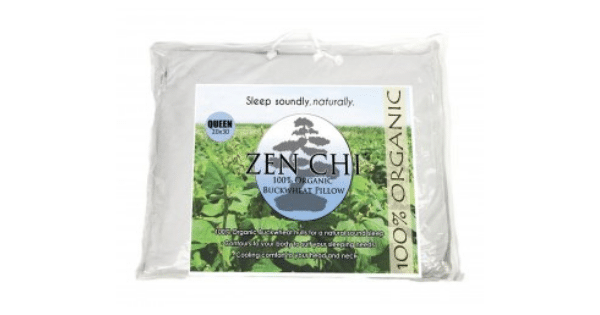
The model will suit every type of sleeper (stomach, back, side, combination) in all weight groups (light, heavy, average who sleep hot. And since it is wholly made from organically-grown hulls, it is an excellent choice for eco-friendly shoppers. You can find it in four sizes – Queen, King, Standard and a smaller Japanese size. The size choice is a huge exception among other buckwheat models that usually have a limited size choice. It has a 30-day sleep trial, and is available for purchase through Amazon and other third-party retailers, with the possibility of different sleep trials. If you are not sure about which model to get, this is an excellent choice for you. And you can even return the product if you are not satisfied with it and get your money back with the Zen Chi’s redeeming guarantee.
Hullo
Qualities:
- Firm’
- 60-day sleep trial
- Adjustable loft
- Sleeps very cool for most
- Close conforming and pressure relief
The Hullo buckwheat pillow is wholly made in the U.S. by the company Hulltex LLC. The case is made from entirely organic cotton twill grown in the U.S. The zypper comes from a Tennessee company Dunlap Zipper. The filling of the pillow – buckwheat hulls, are grown and milled in North Dakota. It is an all-natural product, with no chemical-based feathers or foams that could impact your health and sleep.
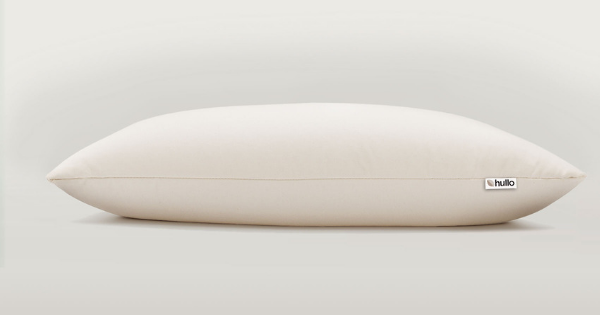
The model sleeps exceptionally cool, even for buckwheat pillow standards. It has excellent airflow in the pillow, a very breathable natural cover, and an adjustable loft. Even though buckwheat models are firm, the firmness allows the pillow to conform to the shape of your head, shoulders, neck, and spine. It might feel hard at first, but it has excellent support for these areas. The shape of the pillow is very adjustable and customizable, with the option to remove, move or add hulls to the pillow, making this product an excellent choice to help with head and neck problems.
The Hullo pillow is suitable for individuals in the average and heavyweight groups that sleep on the side and back, those who sleep hot and suffer from neck and shoulder pain. It is available in three sizes – Small, Standard and King, and it comes with a 60-day sleep trial and free shipping for the U.S.
ComfyComfy ComfySleep Buckwheat Pillow
Qualities:
- Firm
- 60-day sleep trial
- Adjustable loft
- Eco-friendly, durable construction
- Five size options
The ComfySleep Buckwheat Pillow is the best choice for buyers with a bigger budget. It has a higher price than other models, but it offers many benefits. Among those benefits are free shipping for any location in the U.S and a 60-day sleep trial to see if it suits you or not. The pillow also has excellent support with the adjustable loft, and an invisible zipper put there for you to remove or add hulls. The product is very suitable for all types of sleepers in all weight groups (light, heavy, average), individuals that sleep hot, and eco-friendly buyers.
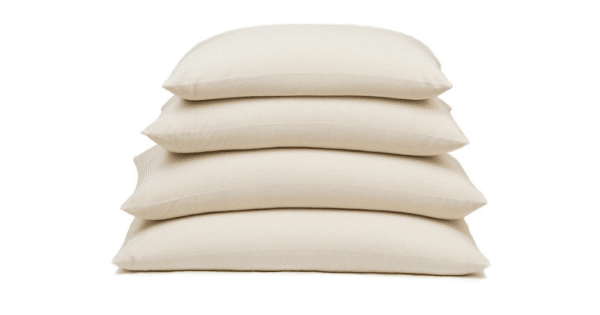
The cover of the pillow is made from entirely organic cotton, and the pillow features organically and USA-grown buckwheat, without any chemicals or fumigants. This model is a very healthy option that will help with your sleep quality. They are designed to be firm with little response to pressure and a moldable feel, even though buckwheat is not a hard material. The firmness happens because thousands of the hulls are stuffed into the pillow. Instead of the pressure response, the cushion permits the sleeper to shape it how they want. It prevents the sleeper from sinking too deep, creates the appropriate position for the body, and excellent spine alignment. However, it does have a soft feel and a breathable surface that improves your sleep quality. It is available in five sizes – Standard, Queen, Traditional, Classic, and Classic Plus. The last three sizes are perfect for reading or traveling. Depending on the size, the weight ranges from four to eight pounds. And it does not have any odor because it is organic and natural, without any chemicals or fumigants used. Because it is firmer, it is an excellent fit for all sleepers, but it might be more comfortable for back sleepers than for those who sleep on the stomach or side.
Buyer’s Guide for Buckwheat Pillows
We’ve discussed pillows made from buckwheat, but you may be wondering what that is exactly. It is a plant with edible seeds that is often used as a cover crop. The hulls are husks that protect the seeds of the plant. These hulls are what the pillows are filled with. Buckwheat pillow benefits are very diverse and excellent. Because they are very dense, they can be firmer, but still very supportive and able to conform to the body. The molding of the hulls gives great pain and pressure relief.
Pillows made from buckwheat hulls are completely natural and hypoallergenic. They do not have any odors or hazardous materials that will interfere with your health. And because they are completely natural, they have lifespans that are much longer than the average.
But these pillows are not entirely flawless or perfect. Like all things, they have their downsides. The hulls can clump which can cause the pillow to deform and lose its shape. The loss of shape is very bad for the body, and it will require additional adjustments while laying on it. Apart from that, these models can also be heavy, with a weight of ten or more pounds. And the price is significantly higher than other pillow types.
Characteristics of Buckwheat Pillows
Although buckwheat models are more expensive than other types and generally hard to find, they offer a wide range of benefits you cannot find in other models. Because of their stable and adaptable surface, they can easily conform to the shape of the body while being firm. They provide exceptional support to the shoulders, neck, and head, and give excellent spine alignment. Because of their natural materials, they are hypoallergenic and best pillows for allergy sufferers, unlike pillows made from materials like latex, down or feathers. And due to their environmentally-friendly construction, they also have excellent air circulation, and because of that, they retain a small amount of body heat.
Because of their excellent support, the buckwheat models provide a stable surface, and they keep your head upright in order to stop and prevent snoring for individuals that experience these issues. And with their excellent airflow, they are the best cooling pillows. Even though they are made from natural materials, they tend to have some odor that might be unpleasant. The hulls are very durable and hard, which is why these pillows have a long lifespan.
However, pillows made from buckwheat are very heavy, with the average Standard size model having ten pounds, and Queen and King size having more. Their weight makes them hard to move while adjusting your sleep position. And they tend to make cracking sounds when you apply weight on them the first few times. But the sound disappears over time. But they mold to the sleeper’s body to create a shape suitable for the body, with the exception of the models that don’t have adjustable loft.
With these benefits and disadvantages, they are most suitable for back and side sleepers. These sleepers will be comfortable in buckwheat models because of above-average conforming and very stable surface. Since it has excellent airflow and a breathable cover, it is an excellent choice for those who sleep hot. And the natural materials make it suitable for those who snore and have allergies. But they might not be ideal for individuals that tend to snuggle with their pillows or struggle with moving the pillows because these models are very heavy. And since these models can be loud, it is definitely not a good choice for those who wake up easily.
Teens need more sleep so that they can function properly and pass the exams, and that’s why it is crucial for them to have the right mattress. If you are a parent searching for the right product, Counting Sheep’s buying guide and top picks for the best mattresses for teenagers can help you make an informed decision and choose the best mattress model.
Living with teenagers feels like you’re on a non-stop thrill ride, all because of their crazy hormones. Their bodies change big time, and so does their need for shut-eye. Teens have got to sleep plenty to nail their exams, so picking out the top mattress is super important for parents with kids hitting those growth spurts. When hunting for that perfect sleep spot, make sure it hugs them right, because growing up can make getting good sleep tough. Lucky for you, there are tons of options out there that match what they need perfectly. We’re about to reveal our top picks that guarantee your teen a one-way trip to dream town, giving their sleep quality and duration a big boost. Ready to find out our favorites for beating this challenge? Here’s the lowdown:
Bear Hybrid Mattress
One of the best things about this model is that, although it is made with quality materials, it has a price that is below average compared to other hybrid mattresses. It is a smart investment for most households, and parents can rest assured their money was wisely spent. This model is medium firm, and it is around 6 out of 10 on the firmness scale, with 10 being the firmest. It is an excellent option for teenagers in the average and heavyweight group, and every sleep position.
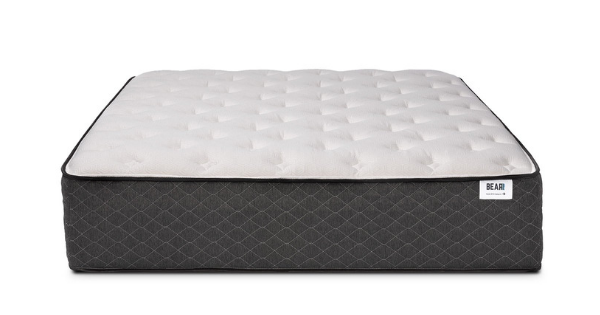
The Bear Hybrid has a Celliant fabric cover that improves blood circulation, increases the tissue oxygenation, and stays cool. It is an excellent solution for teenagers who are physically active. The first layer provides a quick response to pressure, has the right bounce, and it is made with Bear’s signature performance foam. The next is the layer of gel-infused memory foam, and it aids in cooling. The third layer is the pocketed coil support core, and it adds bounce and responsiveness to the mattress. The last is the base layer made with high-density polyfoam, and it is 5 inches thick.
This mattress minimizes pressure points in sensitive areas, and it sleeps very cool. It doesn’t retain heat from the body, and teens don’t have to worry about night sweats on this mattress. It responds quickly to the applied pressure and has the right bounce. Additionally, it has strong edge support.
The Bear Hybrid has a sleep trial period of 100 nights, warranty of 20 years, and the shipping is free within the continental United States.
Recommended for:
- Every sleep position
- Teens with growing pains
- Hot sleepers
- Average and heavy teenagers
Saatva Mattress
The Saatva alleviates pains and aches throughout the body, and it conforms closely to the sleeper’s body and aligns the spine. This mattress is available in three different firmness options – medium soft, medium firm, and firm, and there are two thickness options to choose from – 11.5 inches thick Custom Slim, and 14.5 inches thick Premium Luxury. Thanks to these available options, Saatva can accommodate different loft and firmness needs of teenagers.
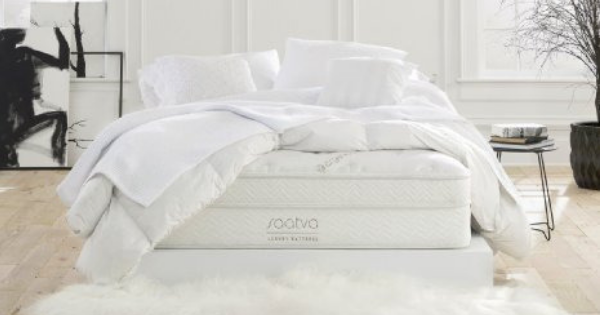
The cover of the Saatva is made with 100% organic cotton, which makes it an excellent option for people who prefer natural products. Euro pillow top is soft, improves pressure relief of the entire mattress, and adds cushioning. The top layer helps keep the mattress cool and offers relief from pain and pressure. The next is the layer of individually wrapped coils that provides bounce. The support layer contains steel coils and offers responsiveness, whereas the base layer acts as a foundation and it is made with high-density poly foam.
This mattress has close conforming and excellent pressure relief. It provides strong and durable support and has a long lifespan. Also, sagging is minimal, and it offers the right level of bounciness and responsiveness. The Saatva mattress stays cool throughout the night thanks to its breathability, has good motion isolation, and it is quiet compared to innerspring models.
The Saatva mattress comes with free White Glove delivery to shoppers in the continental United States, which includes in-home assembly and removal of the old mattress. It is backed by a warranty of 15 years and a sleep trial period of 120 nights.
Recommended for:
- Teens who suffer from back pain
- Average and heavier teenagers
- Every sleep position
- Hot sleepers
Tuft & Needle Mint Mattress
Tuft & Needle Mint is another fantastic model for teenagers. It is made with high-quality polyfoam, and it is very comfortable and supportive. This mattress sleeps cooler compared to most of the other foam models, and it has a reasonable price. It is an excellent option for parents who want a quality mattress for their kids without spending a lot of money.
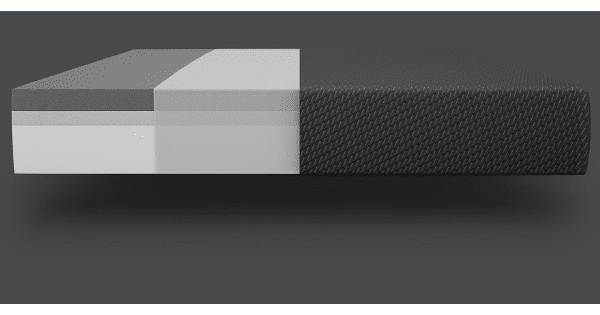
The cover of this mattress is made with polyester and micro-polyamide, and it is very soft and breathable, which helps keep the mattress cool. Fabrics of the cover are resistant to peeling, and the cover has a nice charcoal color. The first layer is made with graphite-infused Adaptive foam made by Tuft and Needle, and it aids in cooling. It has a quick response to pressure, offers fantastic pressure relief, and it is soft. The next layer is 2 inches thick, and it is an Adaptive foam transition layer. Thanks to being infused with gel beads, it offers additional cooling benefits and the right support. Finally, the last layer is 7 inches thick, and it is made with high-density poly foam, which gives support to the entire mattress.
The Mint is medium firm, with around 6 out of 10 on the firmness scale, and it has excellent edge support. It is very durable, has a long lifespan, and provides the right support. It is an ideal model for teens in the average and heavyweight category. Pressure relief is fantastic on this mattress, and it is perfect for teenagers with growing pains. Motion isolation is also excellent.
Tuft and Needle Mint mattress comes with free shipping to customers in the continental United States, free returns, warranty of 10 years and a sleep trial period of 100 nights.
Recommended for:
- Teens with average or heavy weight
- Teenagers with growing pains
- Hot sleepers
- Those who want a durable mattress
Layla Mattress
Layla mattress stands out because of its flippable design. This mattress comes with two different firmness levels, one on each side, and it is a perfect option for those with shifting firmness needs. The soft side is around 4 out of 10 on the firmness scale, whereas the firm side is about 7 out of 10. The Layla is lightweight, which means that teenagers can flip it without any help.

The top layer is made with high-density copper-infused memory foam. It is soft, 3 inches thick, and allows the mattress to sleep cool. The next is the support layer, and as the name suggests, it provides support to the entire mattress. The third layer also supports the bed, and it is 4 inches thick. Finally, the last is the firm layer also made with copper-infused foam. It is up to the buyers to choose which side to put on top.
The Layla sleeps cool, has close conforming and fantastic pressure relief. It is very comfortable and supportive, and an ideal choice for every weight group thanks to two different firmness levels. Thanks to the copper element that improves blood flow, this mattress is perfect for teenagers with poor blood circulation. Motion transfer is minimal on this model.
Layla Mattress comes with free shipping within the continental U.S., sleep trial period of 120 nights, and a lifetime warranty.
Recommended for:
- Every weight group
- Teens with poor blood circulation
- Hot sleepers
- Teenagers with changing firmness needs
Brooklyn Bedding Bowery Mattress
Brooklyn Bowery mattress conforms closely to the sleeper’s body and keeps the spine properly aligned. It offers exceptional pressure relief which is vital as teenagers experience growing pains. This all-foam mattress has a reasonable price, and it costs less than an average foam model, which is excellent news for parents as they don’t have to spend a lot of money on it.
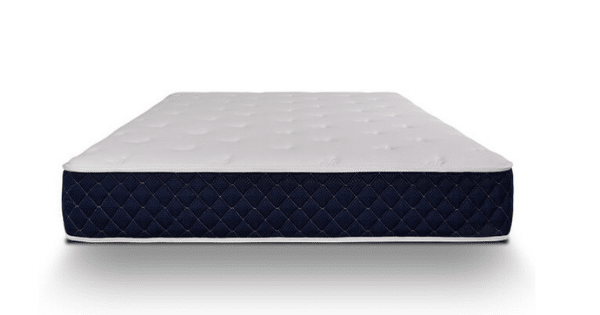
The cover of the mattress is made with a stretch-knit cotton blend, and it is breathable and soft to the touch. The top layer is 3 inches thick and made with Energex foam. It is soft, sleeps cool, and responds quickly to the applied pressure. The next is a transitional layer of polyfoam that provides firmer support. Finally, the last is the base layer which is 5 inches thick and made of high-density polyfoam. This layer adds stability and support to the entire mattress.
The Bowery provides the right amount of support, responsiveness, and bounce. It has a soft feel, and it is around 5 out of 10 on the firmness scale. This mattress has fantastic pressure relief, and there is no need to worry about feeling stuck in it. It sleeps cool as it dissipates body heat, it is virtually silent and very comfortable.
Brooklyn Bedding Bowery mattress comes with free shipping to customers in the continental U.S., warranty of 10 years and a sleep trial period of 120 nights.
Recommended for:
- Hot sleepers
- Teens with growing pains
- Light and average weight category
- Back sleepers and side sleepers
The Allswell Mattress
Another excellent mattress for teenagers is Allswell. This model is medium firm, and it is around 6 out of 10 on the firmness scale, with 10 being the firmest. One of the great things about it is its price. This mattress is inexpensive, which is good news for parents with a limited budget. It provides excellent support and comfort, and the same pressure relief benefits as many high-end competitors, which makes it a smart investment.

The cover of the mattress is infused with gel, and it offers amazing breathability and sleeps cool. It is quilted with 3 inches of super soft foam and memory foam and provides fantastic comfort and excellent pressure relief. The top layer is 1 inch thick and made of Airflow foam, which offers proper contouring and has slow pressure response. The next is the transition layer which is 2.5 inches thick and made of soft poly foam. It acts as a transition between the soft top layer and the bottom pocketed coil layer and adds support. The last is the 7.5 inches thick support layer that contains pocketed coils and offers support and bounce to the mattress.
The Allswell is a supportive mattress with the right amount of responsiveness and bounce. It has minimal sinking without feeling stuck. Breathability of this model is excellent, and it sleeps cool. Additionally, it is very silent and has minimal motion transfer and excellent edge support.
The Allswell mattress comes with a warranty of 10 years, sleep trial period of 100 nights and free shipping within the continental United States.
Recommended for:
- Hot sleepers
- Teens with back pain
- Every sleep position
- Average and heavyweight category
Things to Consider in a Mattress for Teenagers
Some of the most important things that you need to take into consideration if you are a parent of a teenager searching for the right mattress for your child include:
Firmness
Many different firmness levels are available on the mattress market, and most of them range from 3 to 8 on the firmness scale. The most common options are 5, which is medium, and 6, which is a medium firm. Best mattress firmness for teenager varies, mostly depending on their weight. Heavier teenagers usually prefer firm mattresses whereas lightweight teens feel the most comfortable on softer models. If you are not sure about the right firmness, flippable mattresses with dual firmness levels are also available, and they are perfect for those with changing preferences.
Conforming
You need to keep in mind that some models have better conforming than others. If you are buying a mattress for a teenager, don’t forget that they are susceptible to pain and aches because of the development and growth. It is the best idea to opt for a model that conforms closely to the sleeper’s body as these mattresses keep the pelvis, spine, and shoulders properly aligned and relieve pressure on these sensitive areas.
Price
Before you go shopping for a mattress, you need to determine your budget. Some models are more affordable, such as innerspring ones, whereas others are more expensive, for example, latex mattresses. Determine how much you can afford to spend on this purchase. Also, take into consideration shipping costs, as most mattresses come with free shipping only within the continental United States.
Looking for a best electric blanket currently sold on the market? This guide is for you. Learn how they work, common features, safety tips, and discover our top picks for 2019.
For individuals who struggle to stay warm in bed, electric blankets are a perfect solution. Unlike traditional bedding that works to preserve your natural body warmth, these blankets can sometimes be insufficient. Especially in the colder months, electric blankets come equipped with multiple heating options to suit individual comfort levels. They come in different sizes, including Queen and King, which usually have independent heating controls to prevent any disputes over temperature with your partner.
The way they work is pretty simple. There are thin wires between the layers of fabrics. When you plug it in, the wires heat up, warming up surrounding materials, making you warmer faster than the standard bedding.
Lower room temperature is usually correlated with better sleep, but it is also essential to hop into a warm bed, as that will help you relax and fall asleep faster.
Besides keeping you warm, electric blankets are beneficial in some other ways as well. They can help people who have problems with circulation, and can also help ease the symptoms of some medical issues, including fibromyalgia and arthritis, as well as menstrual cycle pains.
If you are wondering about how much electricity they are going to use, don’t worry. You are going to save money on your electricity bill, as you won’t have to turn up the room temperature as much.
Electric blankets are sold pretty much everywhere these days, so you can always get one while shopping at Walmart or order it from Amazon on your next shopping binge.
We have analyzed many electric blankets available on the market today, and we are giving you our top 5 choices.
Best Electric Blankets – Our Top Picks
Soft Heat Low Voltage Heated Blanket
Highlights:
- 11 temperature options
- Shut-off is automatic
- Warranty of five years
- Dual heating options for larger blankets
- Soft polyester microfleece
Soft Heat Low Voltage Electric Blanket is made with the incredibly soft microfleece and ultra-thin electrical wires that support the even heat distribution. It has 11 different temperature settings, so there is undoubtedly one that fits you perfectly. Larger size ones also come with the dual heating settings, so you and your partner can both feel most comfortable while lying together.
The blanket operates on less than 25 volts and it is one of the safest and least energy consuming options.
This blanket offers a few extra features such as a 10-hour automatic shut off timer, and a pre-heat option, so you never have to get into a cold bed again. Also, it can be washed in a washing machine, so it’s easy to clean it.
You can choose between various sizes, five colors and it also comes with a 5-year warranty
Recommended for:
- People with shifting warmth preferences
- Couples
- Sleepers who prefer the soft feel of the blanket
Sunbeam Microplush Heated Blanket
Highlights:
- 10 different temperature options
- Automatic shut-off option
- Warranty of five years
- Dual heating options for larger blankets
- Polyester microfiber
This model is suitable for pretty much everybody. It is made of polyester microfiber that is surprisingly soft and durable. This electric blanket comes with ten different temperature settings, so even the most difficult sleepers will get the temperature they are the most comfortable with.
Sunbeam Microplush Heated blanket also comes with a pre-heat option, to warm your bed before you get in it; and shut off is automatic with a 10-hour timer. It can be washed and dried in the machine as well.
It comes in various sizes, and the King and Queen ones have dual temperature control, so it is suitable for couples. You’ll be able to pick between lots of color options, and you’ll also get a warranty for 5 years.
Recommended for:
- People with changing temperature preferences
- Couples
- Sleepers who want to enjoy the whole night with a heated blanket
Serta Luxe Plush Fleece Electric Throw
Highlights:
- 10 different temperature options
- Shut-off is automatic
- Warranty of five years
- Larger sizes with dual heating options
- Polyester microfiber
The Serta Luxe Plush blanket is made from thin wires responsible for distributing the heat exceptionally well; and incredibly soft polyester microfibers that will feel great on your skin.
This electric blanket comes with ten different temperature settings, varying from light to very warm. It is very lightweight, so besides sleeping in bed, you can use it for anything you want, from covering yourself while reading to putting it on while taking a nap on the couch.
Queen and King sizes come with dual temperature controls, so couples will enjoy using it. It also comes with a pre-heat function, and it is excellent for those who don’t like the feeling of that cold bed, and a shut-off option is automatic and has a 10-hour timer.
The Serta Luxe Plush Fleece Electric Throw comes in four different color options, and you’ll also get a warranty for five years.
Recommended for:
- Couples
- Those who want an exceptionally soft blanket
- People with changing temperature preferences
Sunbeam Quilted Fleece Heated Blanket
Highlights:
- 10 different temperature settings
- Automatic shut-off function
- Warranty of five years
- Larger sizes come with dual heating controls
- Polyester fleece
The Quilted Fleece Heated Blanket is another product from Sunbeam on our list, which shows you how good their electric blankets are. It is made from plush polyester fleece that is great at containing heat, so even if you don’t turn it on, you’ll feel warmer than with your usual cover.
Like the others, it has ten different temperature settings and an automatic shut-off option with a 10-hour timer. Another fantastic feature is ThermoFine smart technology that measures the sleepers’ temperature and makes sure your blanket never gets too warm.
The Sunbeam Quilted Fleece Heated Blanket comes with dual controls for temperature in King and Queen sizes, and it can be washed and dried in the machine, as well.
You can choose between seven color options, and you’ll get a warranty for five years with it. With the price of less than $70, it is one of the most affordable options.
Recommended for:
- People with shifting temperature needs
- Couples
- Those who want an incredibly soft blanket
- Value seekers
Biddeford MicroPlush Heated Blanket
Highlights:
- 10 different temperature settings
- Automatic shut-off
- Warranty of five years
- Larger sizes come with dual heating controls
- Polyester fleece and microfiber
The Biddeford MicroPlush Heated Blanket is made from extremely thin wires that give this blanket a light feel. The one side of the blanket is made from microfiber while the other is constructed from Sherpa fleece, so you can choose the one that feels best for you.
It comes with ten different temperature settings, automatic shut-off option and dual controls for each side of the King and Queen size blankets.
The Microplush Heated Blanket is machine washable, and it can go into the dryer as well. It is available in nine different color options and comes with a 5-year warranty.
Recommended for:
- Sleepers with changing warmth needs
- Couples
- People who prefer double-sided covers with different textures
Essential Tips For Electric Blanket Shoppers
There are some things you need to know before buying an electric blanket to make sure you get the best one for you. Here are a few useful tips and information you need to know before getting one.
Make Sure it is Safe
Even though electric blankets can be beneficial to some people, certain people should avoid using them.
Pregnant women are shouldn’t use hot tubs and should avoid taking warm baths. Same goes with electric blankets as they raise body temperature, and that can cause congenital disabilities. The first trimester is when you should be most cautious.
People who have diabetes could have lower sensibility in the limbs due to lack of circulation and some nerve damage. Because of that, they may not notice if the blanket becomes too hot, and can cause skin burns.
Children, adults with mental disabilities or dementia shouldn’t use them either as these individuals may not know how to adjust the temperature settings and can burn themselves as a result.
If your pet often sleeps with you, the electric blanket may not be for you, as they can be too hot for them. Curious as pets are, they may also chew the blanket and expose the wires.
Pick the Right Size
They come in a variety of colors and sizes so make sure to choose the one you like the best. The size of your electric blanket should match the size of your mattress. The fabrics used to make them are various as well, so you should feel them and pick your favorite.
If you are sharing a bed with your partner make sure you are getting the one that has dual temperature controllers, so that way you can both choose the most comfortable heat setting.
Also, you want to look for the one that has a controller with a bright digital screen, so you don’t have to turn on the light when trying to change your temperature settings.
Clean Your Electric Blanket
Most electric blankets can be washed in a washing machine, but that’s not the case with all of them. So make sure to get the one that can be if you don’t want to wash it by hand.
Before you wash it, make sure to remove the controllers and the plug, and always use the gentle cycle option on your washing machine, as well as the low-temperature option if you decide to put it in a dryer.
Of course, always consult the washing instructions and make sure you are caring for your blanket correctly.
Take Proper Care of the Electric Blanket
It is at uttermost importance that you follow the care instructions and maintain your electronic coverage properly.
Make sure you don’t fold it while it’s turned on, as it can lead to creating “hot spots” that can then burn you. Also, make sure that you don’t put anything on top of it, as it may sometimes lead to overheating and burning.
Always keep it turned off when not in use, and make sure you don’t put anything heavy on top of it when storing it, if you want to avoid potential damage to the wires.
Don’t put it directly on memory foam mattress as they can be sensitive to heat. The way they work is that they contour the best way possible based on your body heat and pressure so that excess heat can mess that up.
Check for Brown Spots
If you see any brown spots, stop using your blanket immediately! That is a clear sign that your favorite coverage has suffered some burn damage and that you should shop for the replacement.
Make sure you don’t buy the used one, and if you want to get the maximum life out of it, try not to use it on high-temperature settings, so that way it doesn’t overheat and last a bit longer.
Occasionally check the cord and other electric parts for any visible damage.
Electric blankets can be a great aid if you are living in areas with cold climates or are just struggling to keep warm during the night. They can be a perfect addition to the elderly in your family, as the circulation, as well as other things, deteriorate with age.
The temperature can also affect your aging and longevity.
Be aware that some sleep experts say that the best way to use electric blanket is to warm your bed up before hopping in it, and then turning it off for the rest of the night.
That is all you need to know about different features of electric blankets, what you should look for when buying one, and how to take proper care of them. Our top five list is carefully selected and reviewed so that we can help you make the best choice easily.
Thinking about getting a rollaway bed? Check out top list and buyer’s guide to make an informed decision, and find the best rollaway bed for you!
Usually, the image that comes to mind when we think of beds is that of a substantial, immovable wooden structure holding up a thick, comfortable mattress topped with pillows. Nonetheless, sometimes fitting a large bed into a living space can be difficult, leading one to look for other options.
The rollaway bed, also known as a folding bed, can be a great affordable alternative. It can be a fantastic option if you are struggling with free space or you need some extra sleep options when you have some guests over. They are often used in the hospitality business, as guests at hotels and hostels sometimes need an extra bed in their room, and they are an easily portable solution.
One study showed showed that a new bedding system can also improve the quality of sleep and reduce back pains so that this affordable option could be beneficial to your rest too.
Most of today’s rollaway beds have metal frames and wheels, and they can be folded, transported and stored as needed. Usually, they come with a mattress that is 4 to 6 inches thick and made from polyurethane or memory foam. Most models can support up to 400 pounds, which means that they are good for single sleepers, even heavier ones; as well as two lighter individuals.
Prices vary, but they are a lot cheaper than your standard stationary beds, and you can find excellent models for less than $500. Since there are many rollaway beds on the market, we decided to make this guide and help you choose the best one. We have also included our top 4 picks, so be sure to check them out.
Common Features Of Rollaway Beds
Although there are so many rollaway beds on the market, all of them share the same construction pattern:
- A firm, steel frame that has a folding mechanism. Some have reinforced frame for more bed support.
- A mattress that is attached to the frame, and is usually 2 to 5 inches thick. Most models are innerspring or foam based.
- A frame base that supports the mattress. It is usually made of metal springs or mixed fabric to build a trampoline-like base. Some have wooden or metal slats instead.
- At least four caster wheels that offer easier mobility and storage. There is usually the lock on the wheels so that the bed stays in the place while you are sleeping.
They also have some similar common features:
- Lightweight: Rollaway beds are relatively light, and they usually weigh between 30 and 70 pounds depending on a model. Their weight and the fact that they have wheels make them easy to move around.
- Weight capacity: Since they are a lot lighter than your standard bed, rollaway beds can also support less weight. The weight limit for almost all of them is 400 pounds or less. That’s why they are mainly designed for single sleepers.
- Limited sizing: Folding beds are usually available in Twin, Full and Queen size. They also may be smaller sizes available, such as ‘Narrow Twin.’ Queen size is the rarest, while they don’t come in King and California King bed sizes.
- Headboard: Because the main focus is on increasing portability and storing potential, rollaway beds usually don’t have headboards.
- Affordability: Folding beds are a lot cheaper than the standard ones.
Our Top Picks – Best Rollaway Beds
Zinus Resort Folding Guest Bed
Highlights:
- 5” mattress
- Polyurethane and memory foam
- 250 lbs. weight limit
- Steel frame
- 19” bed height
- Size: 38” x 75” x 19”
- Weight: 67.8 lbs.
- 1-year warranty
The Zinus Resort Folding Guest Bed has a steel frame and a 5” thick mattress. It is thicker than most rollaway bed mattresses, and with a 4” polyurethane layer and a 1” memory foam layer on top, it is a pretty comfortable option. It offers excellent cushioning and support, and sleepers won’t experience aches and pains when sleeping.
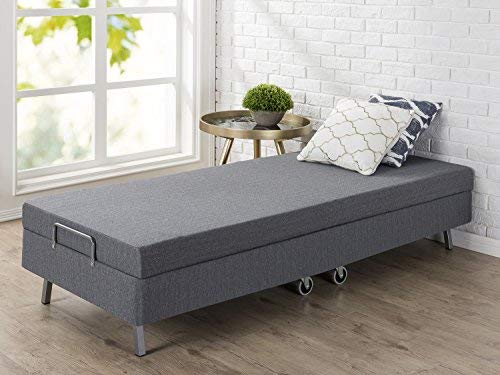
The bed has a modern design, and it can be placed in any living space without any problems. The memory foam layer is made from natural materials and added green tea extract, which eliminates odor and moisture and adds freshness to the bed.
Steel frame weighs 67.8 pounds, and the size is 38” x 75” x 19”. The bed can support up to 250 lbs., so it is mainly suited for single sleepers. Also, it is very easy to use thanks to folding straps and wheels.
It comes at a reasonable price, and you get a one year warranty with this product.
Good for:
- Single sleepers who weigh less than 250 pounds
- People who often suffer from back pain
- Children who weigh less than 250 pounds combined
Milliard Premium Folding Bed
Highlights:
- 4” memory foam mattress
- 400 lbs. weight limit
- Steel frame
- 16” bed height
- Size: 75” x 31.5” x 16”
- Weight: 52.4 lbs.
The Milliard Premium Folding Bed has a reinforced steel frame, a trampoline base and clamshell-like folding mechanism that is easy to use. It is one of the most durable rollaway beds, and it can support as much as 400 pounds, which makes it an excellent option for single sleepers and couples.
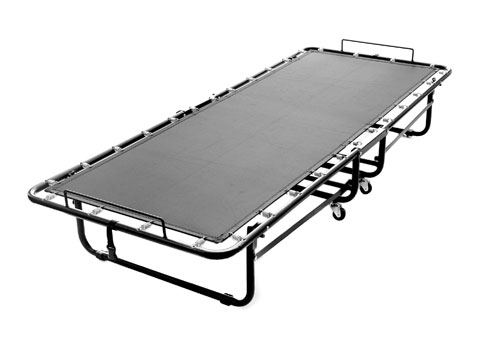
Great trampoline base and a 4” memory foam mattress offer good back support, and you will find sleeping on this bed extremely comfortable.
The Milliard Premium Folding Bed takes no effort to set up; 360-degree rotating wheels and moderate 52.4 lbs will allow you to move it around the house with no problem.
Good for:
- Single sleepers who weigh less than 400 pounds
- People who often suffer from back pain
- Couples or children who weigh less than 400 pounds combined
Lucid Rollaway Guest Bed
Highlights:
- 4” mattress
- Polyurethane and memory foam
- 350 lbs weight limit
- Steel frame
- 12” bed height
- Size: 31” x 74” x 14.5”
- Weight: 44 lbs.
- 1-year warranty
The Lucid Rollaway Guest Bed has a sturdy steel frame and 4” thick mattress made of a 3” layer of polyurethane foam and a top 1” memory foam layer. The density is perfect, and even though this is not one of the thickest mattresses, it is one of the most comfortable folding beds.
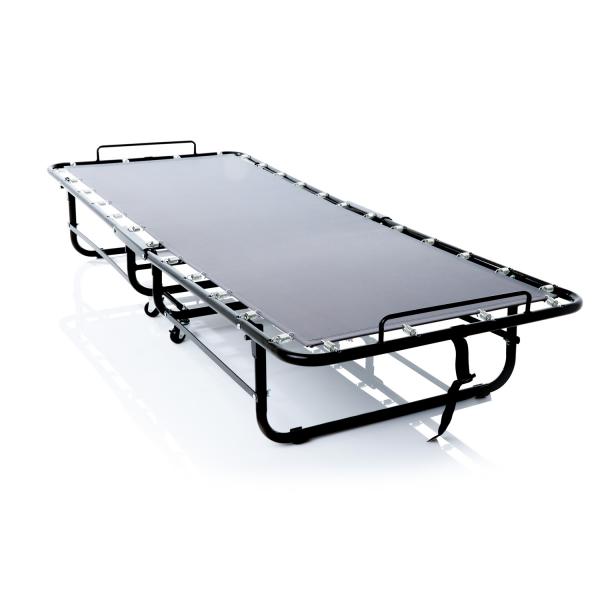
The bed comes in multiple sizes and can support up to 350 pounds, so it is good for single sleepers and couples.
The Lucid Rollaway Guest Bed is one of the most durable folding beds on the market, and you’ll even get a 10-year warranty with it, which is more than what other manufacturers provide.
Good for:
- Single sleepers who weigh less than 350 pounds
- People who suffer from back pain
- Couples or children who weigh less than 350 pounds combined
Zinus Sleep Master Weekender Elite Folding Bed
Highlights:
- 4” mattress
- Polyurethane foam and fiber padding
- 250 lbs. weight limit
- Steel frame
- 18” bed height
- Size: 31” x 75” x 18”
- Weight: 30.9 lbs.
- 1-year warranty
The Zinus Weekender Elite Rollaway Bed has a steel frame and a 4” mattress made from a 3” foam base and top 1” layer of fiber padding, allowing you to sleep cooler compared to mattresses made entirely of foam.
You’ll be comfortable using this rollaway bed, and with a weight of only 30.9 pounds and four wheels, moving and storing will be quickly done.
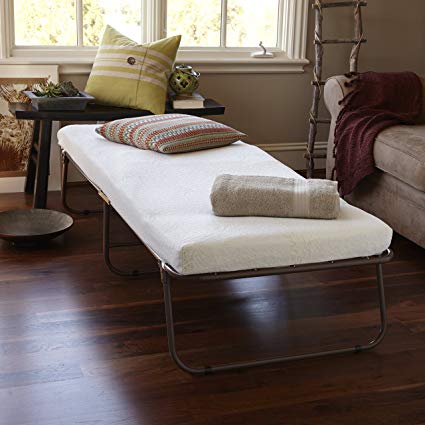
With the spring base, you won’t get as much firmness as with some other options, but it is comfortable, and it can support up to 250 pounds.
The Zinus Weekender Elite Rollaway Bed costs less than $120, which makes it one of the most affordable options available, and it is backed by a warranty of one year.
Good for:
- Single sleepers who weigh less than 250 pounds
- Children who weigh less than 250 pounds combined
- Those who like a colder sleeping place
- Value seekers
Pros And Cons Of Rollaway Beds
Pros:
- Affordability: The average price of rollaway beds is around $500, which makes them a lot cheaper than your standard bed and mattress. That’s why they are an excellent solution if you have occasional guests around and need some extra sleeping space.
- Light and easy to move: They weigh less than 70 pounds and come with caster wheel, which offers convenient mobility.
- Convenient storage: Because of the metal frame, thinner mattress, and a folding mechanism, they are easy to store.
- Temperature neutrality: Thinner mattresses retain less body heat, so you’ll be cooler during the night which is essential to the quality of sleep.
Cons:
- Less durable: The average lifespan of a rollaway bed is seven years which is the standard average lifespan of all mattresses. The more you use it, the quicker it will deteriorate.
- Noise: Because of the metal frames and springs, they usually produce squeaks and cracks, which can be annoying to some users.
- Below-average support: Rollaway beds usually offer less support than the standard mattresses. That’s why sleepers are more at risk to develop pains and aches when sleeping on a folding bed.
- Limited warranty: The warranties for rollaway beds are rearer and usually only one year long. Also, the trial period, if it exists, is 30 days compared to a 90 day trial period for a standard mattress.
What To Consider When Buying A Rollaway Bed?
Price: They are sold for $100 to $500, but be aware that the pricier models are also correlated with longer lifespans.
Usage: If you need the bed occasionally, getting a cheaper one might be a better option. If you have guests over frequently, or you plan to use the rollaway bed often, go for one of the pricier models.
Size: Make sure to buy the size you need. Also, see if it fits in the storing space where you’ll put it while not using it.
Weight capacity: Rollaway beds usually have 225 to 400 pounds limit. They are mostly intended for single sleepers, while some can support two people. Be sure to check how much weight it can carry, as that could be a problem with heavier individuals.
Noise: Having a quiet bedroom is good for getting a good night’s sleep. The models with metal frames are usually more squeaky.
Frame and base: Wooden frames often provide better support and are more durable, while metal ones provide more convenient portability and storage. The trampoline-like base also offers the best support for the mattress.
Mattress: You can choose between innerspring and foam mattresses. The innerspring ones are less expensive and retain less heat during the night, but they can be a bit noisy. Foam mattresses are more expensive, but quiet and more durable. They also keep more heat, so if you have problems warming up at night, they might be a better choice.
You also want to consider the thickness of the mattress, as the thicker ones are more comfortable but are also bulkier to move and store.
Sleep trial and warranty: Sleep trials are usually 30 days long, compared to a 90-day trial for conventional beds. Warranty coverage goes up to 10 years, but those are rare, and most models are not even covered by a warranty.
Hopefully, this guide provided you with enough information to help you decide what rollaway bed is the best for you. Be sure to check everything you need to know from size to how much noise they make. Also, make sure to look up some of the reviews online, as they can give you additional feedback about the products.
Is dry air messing up with your sleep? Maybe a humidifier can help. Check out our reviews for the top-rated humidifiers for bedrooms.
Winter season is always filled with love and laughter due to the holiday spirit, giving gifts, and making New Year’s resolution. Once that is over the only things, we are left with are few extra pounds that we hide under our sweaters (Hey, it’s holiday season we won’t judge) and something most of us don’t like – dry air.
Sure, we don’t sweat as much as we do during the summer, but dry air can cause difficulty breathing during the night, make our lips chapped, skin dry, and worsen our allergies. The optimal indoor humidity when it’s winter should be at around 45%, but it usually drops to about 15% due to cold weather. Of course, we cannot influence the outside conditions. Luckily, we can do that indoors with the help of a humidifier. What are the benefits of using it and which ones are the best? We are about to find out.
Buying Guide – Important Considerations
The purpose of humidifiers is to boost the level of moisture in the air, and that will help you to breathe easier especially if you have asthma, and it can help you recover from a cold faster. We will cover basic questions that people ask when choosing the best humidifiers.
How to choose the size of humidifier? – Most humidifiers have a coverage area indicated in the description of the product. That is room size which it can humidify properly. Medium and small are for single-room only, due to its size it can be quickly moved to other rooms, but you will need to fill the tank often. On the other hand, extra-large and large ones are a great solution for multiple rooms as they are not intended to be portable, but in the bright side, you don’t need to refill the tank as much.
Which is a better option warm or cool mist? – It depends on your preference.
- The warm mist humidifier kills the germs more effectively and can help with the stuffy nose, but on the downside, it’s noisier as it has to boil the water and the container becomes hot to touch, so it’s not recommended if you have pets or small kids that can accidentally hurt themselves.
- The cool mist a humidifier covers bigger areas and uses less power, so you save on your electricity bill, but you will need to clean it more frequently.
What is the average price of a humidifier? – It can vary from 25 dollars to 100 dollars, depending on the area it needs to cover. Also, extra features such as a display which is LED, humidistat, etc. will add to its value.
How to keep a humidifier in good condition? – It is vital to clean it properly because without that it cannot do its job the way it was intended. This means it will drain your electricity more and can cause bacteria and mold to appear. Most humidifiers come with detailed instructions on how to clean it.
Can humidifier help me if I have an allergy? – Yes. People who have an allergy say that humidifiers tend to help them breath better and fall asleep easier. But to be safe, it is better to use filtered water in humidifiers than tap water because ultrasonic humidifier creates vapor that can make thin white dust that could be bothersome to people who are prone to allergies.
Is it safe to use essential oils in a humidifier? – It depends on the humidifier. If a product that you bought can be used as a diffuser and a humidifier, then it is okay, but always check with the manufactures because every product should be used as intended.
Our Top Picks
The AirCare MA1201 – The Best Whole House Humidifier
If you can’t bother to move your humidifier from one room to another, this model is an excellent choice for you. It covers up to 3 600 ft² and it can run for 36h, so you don’t need to worry about turning it on again after a short period. Even though it’s a large room humidifier, it does not take much space as it is 2’ tall, and it has wheels so that you can move it anywhere you like with ease.
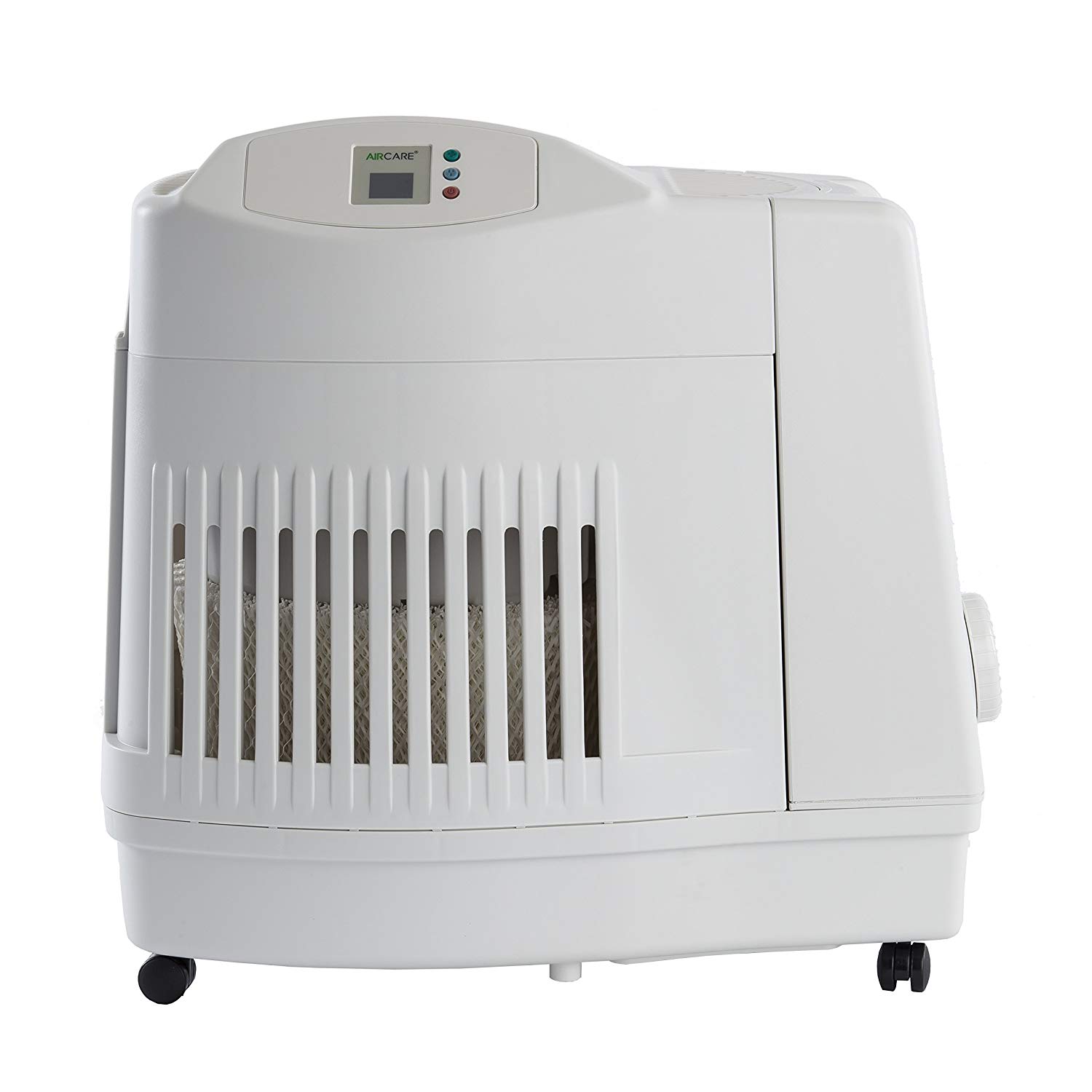
The AirCare MA1201 has four speeds of the fan and a humidistat, so you don’t need an external meter for the humidity. It also contains customizable humidity settings and automatic turn off option when the tank has no water or if the optimal level of moisture is reached. The best part of it is that it’s easy to clean, just replace wicks and filters.
It comes with two years of warranty and 30-days warranty on the wicks and filters.
This model is an economical choice as buying multiple humidifiers can be more expensive.
Key Points
- The cool mist humidifier with humidistat
- Large coverage area
- Lasts up to 36h
- Two years of warranty
The Honeywell HCM350B – The Best for Allergy
The Honeywell HCM350B uses the technology of UV killing up to 99.9 percent of harmful bacteria. The tap water goes through a filter then into water that that contains UV before it goes out to the bedroom. This system ensures that the bacterial growth is minimized almost to none. That is why this is one of the best humidifiers for allergies, and cleaning won’t be bothersome because all parts are safe for the dishwasher.
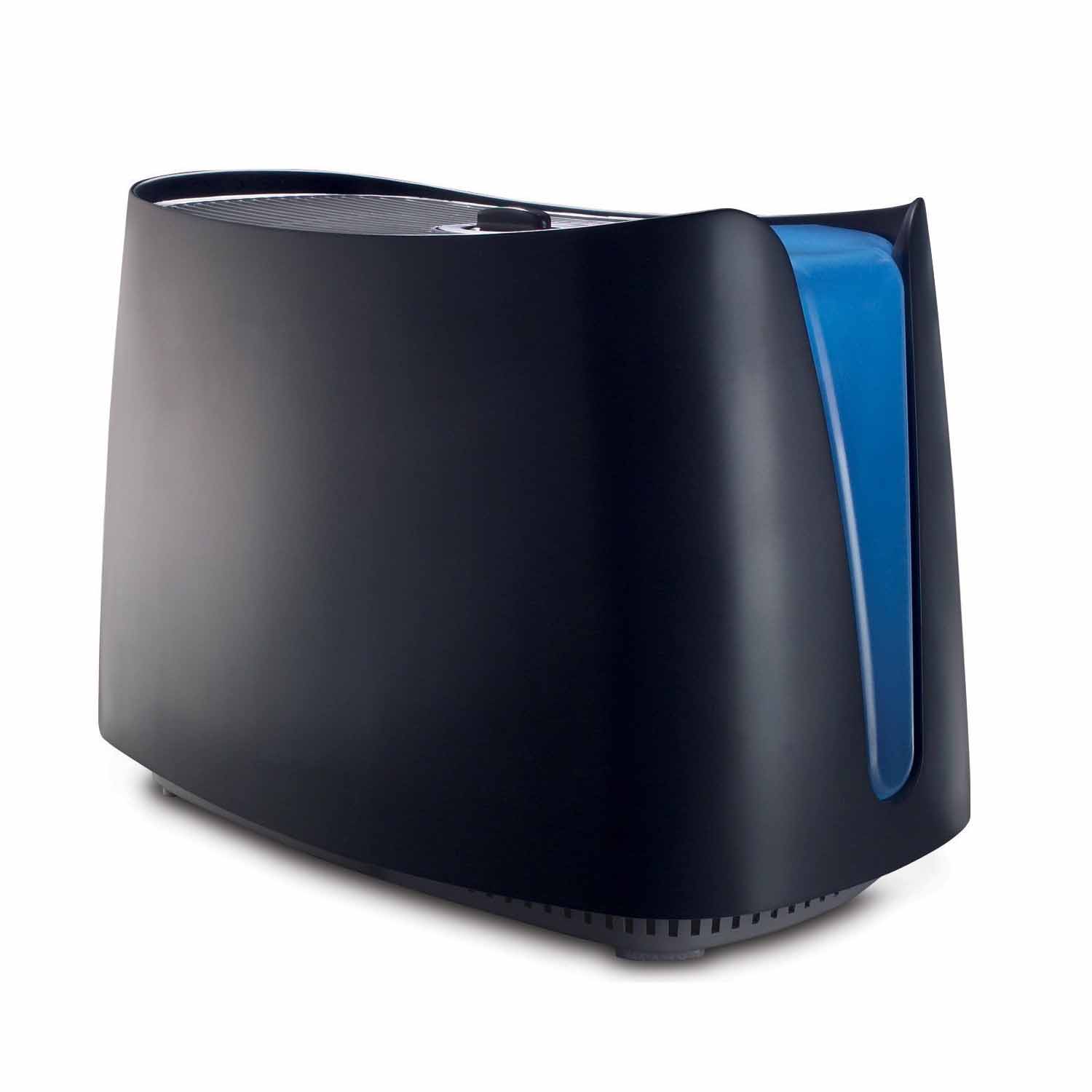
This humidifier can last up to 24h, and since it is a tank of one gallon, it can easily fit in your sink. Honeywell HCM350B is a cool mist humidifier so, it is safe to be used in the kids’ room, and you can choose between black and white design.
This product comes with a warranty of 3 years, but due to its UV technology system that effectively kills the bacteria, the price is a bit higher than average. You will need to buy filters now and then that cost about 10 dollars each.
Key Points
- The cool mist humidifier
- The unique technology that contains UV killing 99.9% of bacteria
- Lasts up to 24h
- Three years of warranty
The Vicks Warm Mist Humidifier (model 745A) – The Best Humidifier for Sinuses
If you often get sick during the flu or cold season, this humidifier will help you mild the symptoms of congestion because of its warm and comforting vapor. The mist level is also adjustable.
The Vicks Warm Mist Humidifier 745A is designed in that way to help you sleep while you’re sick. All you have to do is to add VapoSteam Vicks into the medicine cup that is included, and you will create a mist that is medicated to help you breathe better and temporarily stop you from coughing while optimizing humidity level in the room.
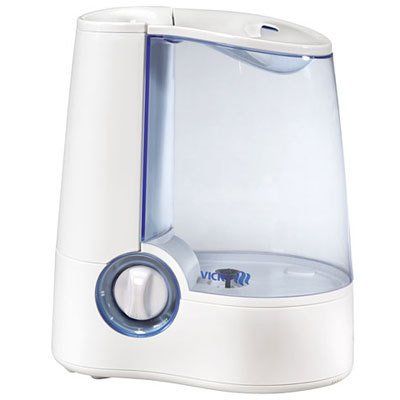
The transparent design of the tank makes it obvious when you need to refill it, and it shuts off as soon as the tank is empty preventing it from overheating. An extra feature is a nightlight that comes with the humidifier.
The Vicks Warm Mist humidifier’s price is around 40 dollars, and one of its perks is that it doesn’t have a filter so you won’t have an additional cost. It comes with a warranty of three years.
Key Points
- Humidifier with warm mist
- It can kill up to 95 percent of harmful bacteria.
- Lasts up to 12h
- Warranty of three years
The Crane Ultrasonic Cool Mist Humidifier – The Best Humidifier for Baby
One reason the Crane Ultrasonic Cool Mist Humidifier is highly regarded for use in nurseries is due to its cool mist output. This feature is key for soothing your child during sick days. Furthermore, it contributes to a healthier breathing environment by removing up to 99.96% of germs, courtesy of its antimicrobial base. Yet, it’s most effective in areas no larger than 500 square feet, rendering it ideal for more intimate settings.
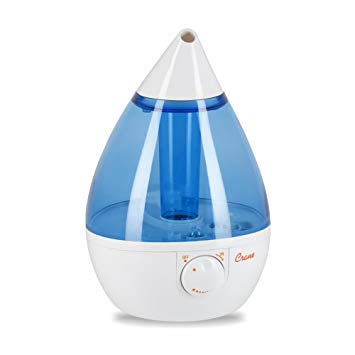
The design of the Crane Ultrasonic humidifier is very suitable for the nursery room as it is teardrop shaped and you have various colors to choose from so, it will work with almost any décor well. It has a shut-off feature when the tank is empty, and it runs up to 24h, but more importantly, it is quiet and energy efficient which means your baby will get a good night sleep without disruptions.
The tank is filter-free, so you won’t have to worry about the additional cost. The humidifier comes with a warranty of one year.
Key Points
- Provides a cool mist
- Lasts up to 24h
- Warranty of one year
- Free from 99.96 percent of bacteria
The VicTsing Essential Oil Diffuser Plus Cool Mist Humidifier – The Best Humidifier/Diffuser
Lovers of aromatherapy will enjoy the VicTsing Difuser Plus Cool Mist Humidifier as it is oil diffuser and humidifier all wrapped into one. It also includes seven nightlights that are LED for a completely relaxing atmosphere. If you need a smaller one to take with you on your trip, the six inches size would be your perfect companion. If you want to use it home, we recommend using it in smaller rooms like nurseries for higher humidity coverage.
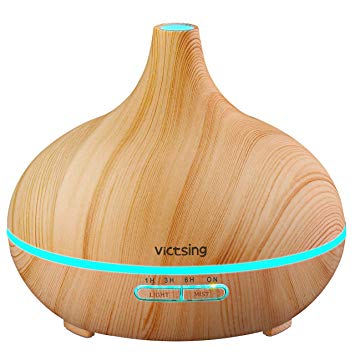
Wood grain complements the simple, elegant design that is featuring two mist settings and four-time options. On the lowest humidity setting, it can last up to 10h. This might not be a good option for those who need a more extended period of humid air, especially during the night.
The VicTsing is primarily used as an essential oil diffuser and then humidifier which is great for those that are on the go and need aromatherapy to sleep. You get a warranty of one year.
Key Points
- Diffuser for essential oils
- Lasts up to 10h
- Awarranty of one year.
- Provides a cool mist
The TaoTronics Cool Mist Humidifier – The Best Humidifier Display
If you are a tech-nerd, you will love the TaoTronics Cool Mist humidifier because it has a mist nozzle of 360 degree that rotates as you sleep, a humidistat that monitors humidity level with three mist options and a timer that works up to 24h. All of that can be seen on a fancy LED display.
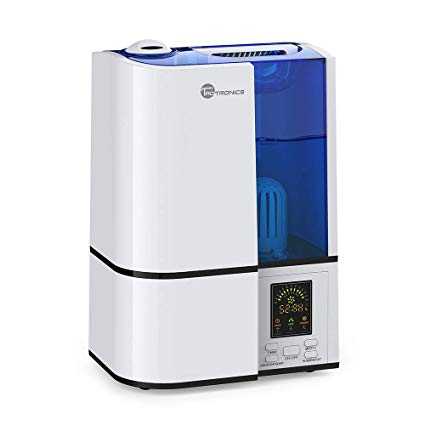
The TaoTronics makes noise that is less than 38 dB and works best in rooms that are up to 538 ft². The product includes a cleaning set, and new filter replacement will cost you 8 dollars each. You get a warranty of one year.
Key Points
- Humidifier withcool mist
- A warranty of one year.
- Contains humidistat
- Lasts up to 15h
The Pure Enrichment MistAire Humidifier – Our Editor’s Choice
The best for last, the Pure Enrichment MistAire Humidifier is an ultrasonic humidifier that is operating on quiet mode, so you get no disruptions during sleep. Its sleek modern design will add to your décor rather than being an eyesore, and it also includes a nightlight that provides a soothing glow for those who prefer not to have complete darkness.
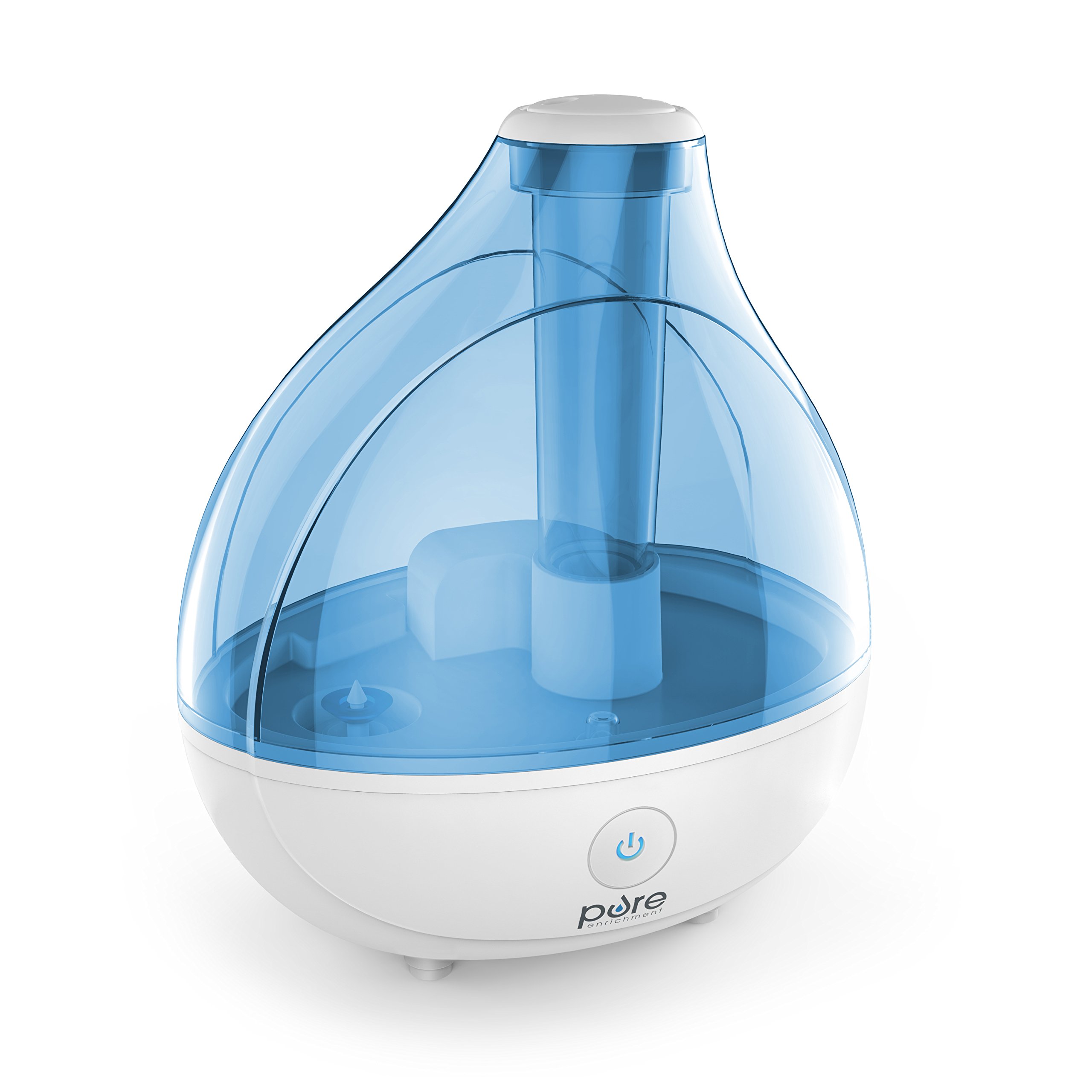
The size of the humidifier is enough to ensure optimal humidity in most bedrooms. On the lowest setting it can last up to 16h, and you get a shut-off feature whenever the tank is removed, or the water level is too low.
The Pure Enrichment MistAire humidifier comes with AC adapter, a cleaning set and a manual. All parts can be easily removed in order to be cleaned. Most importantly it is very affordable. You get a warranty of two years.
Key Points
- The humidifier that provides a cool mist
- Lasts up to 16h
- A warranty of two years
Quick Reminders
- To besurethat the humidifiers have a high humidity coverage in the room by checking the size of it and the maximum area coverage.
- Make sure you use the humidifier as intended. Consult the manufacturer before adding essential oils.
- Always have a habit of rinsing, and drying the humidifier’s reservoir daily and clean it deeply with a disinfecting agent and vinegar to stop potential growth of the bacteria and mold.
Thinking about buying a mattress on Amazon? Find the best one for your budget with our reviews and detailed buyer’s guide!
Amazon.com is home to an extensive array of mattress choices. Embarking on the path to select a new mattress can be overwhelming, cumbersome, and protracted for those not well-acquainted with its broad catalog. Wondering how to choose? This guide is here to simplify that by spotlighting the best mattresses on Amazon in 2019. In doing so, we aim to save you the hassle of sifting through subpar selections, thereby conserving your time and energy, and ensuring you make an informed decision. Rest assured, the mattress you pick will offer the support and comfort you need for the foreseeable future. Let’s dive in!
Our Picks
Sleep on Latex 9″ Pure Green Mattress
One of the most eco-friendly options on the market, Sleep on Latex Pure Green Natural Latex mattress offers both exceptional support and lots of comfort. It is manufactured in Chicago and made using 100% organic cotton, completely natural latex foam and pure, 100% organic New Zealand wool. One of the main benefits of using these materials is the low level of body heat absorption. It ensures that you never wake up in the middle of the night sweating up a storm, especially if you pair this mattress with a high-quality mattress pad for overkill levels of comfort. The top layer of the mattress is comprised of a cozy wool cover over a softer blend of natural foam, adding extra softness to an already comfortable mattress design.
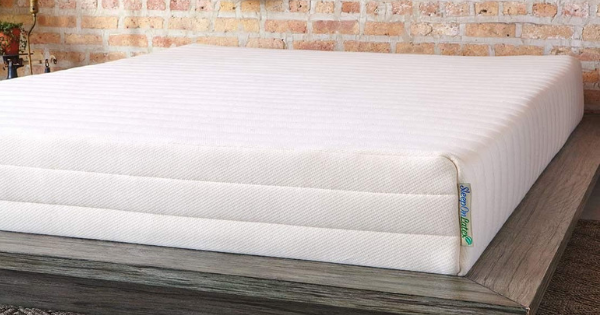
You have three firmness settings to choose from, ranked on a firmness scale of 1-10. The softest version clocks in around 3.5 on the firmness scale, meaning you sink into the plush comfort of the mattress. The medium option ranks at a solid 5.5-6 on the firmness scale, being versatile in its performance for many different body types. The firm option is at least a 7.5 on the firmness scale, offering exceptional levels of support for heavier sleepers. This level of flexibility in firmness variations lets the customer perfectly tailor their sleeping experience based on their sleeping position, body shape, weight, and any other criteria.
Ordering this mattress from Amazon comes with perks like a whopping 10-year manufacturer’s warranty and the classic 30-day sleep trial. It means you can safely try out the mattress of your choice, and return it if it’s not entirely to your taste. This level of customer care is one of the main reasons Amazon is as widespread and popular as it is.
Tuft & Needle Mattress
Polyfoam has traditionally been a sub-par material to construct mattresses from. Most models you find that use this blend offer very little support and aren’t flexible enough to adapt to your body shape. Not the Tuft & Needle, though. Tuft & Needle mattress is made primarily out of patented T&N Adaptive foam, which includes cooling gel and heat-wicking graphite. It allows you to sleep cool no matter the conditions outside and is one of the key components of getting a night of restorative, healthy sleep. The cover offers above-average breathability, and since air circulation is a core factor in how quickly you can fall asleep, we consider this an impactful selling point.

The support is enhanced by an extra-firm core of T&N foam, ensuring that the mattress doesn’t stop being comfortable after an hour or two of active sleep by changing shape enough to lose its softness and ideal form. The flexibility of the top layer doesn’t cause the whole surface of the mattress to wobble as you move. If your spouse or sleeping partner easily wakes up through nearby movement, this mattress helps you leave and enter the bed or turn around without disturbing them. It is called motion isolation and coupled with the Queen and King-sized options for size – it’s a premium-quality mattress for couples.
Tuft & Needle back this mattress with a very confident 10-year warranty. The quality of their adaptive foam doesn’t show signs of faltering even past that point, however, so you can be confident in the mattress’ durability and support. Ordering from Amazon gives you the same benefit as getting the product directly from T&N – you have a very generous 100-night sleep trial, during which you can return it if you have issues. The price is almost a steal for a mattress of this quality.
The Original Purple
One of the most elegant and awe-inspiring pieces of design we’ve seen recently, the Original Purple mattress has it all. The patented Purple Smart Comfort Grid aligns perfectly to your body’s unique shape and helps relieve pressure and pain on your joints. This grid is composed of a foam grid that holds a special gel that gives it an optimal level of flexibility and comfort. The polymer has a big durability advantage over materials normally used for the comfort layer (there is normally a risk of early deterioration, but not here), which helps the mattress surpass its 10-year warranty with ease. The special temperature-neutral and open grid design creates a very healthy airflow and ensures you can sleep cool even during peak summer temperatures, giving you that edge in performance for the next day. This breathability is enhanced further by the Lycra spandex cover.
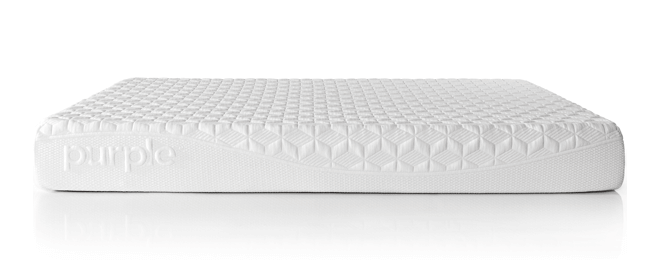
The brunt of the supportive power comes from a very dense layer of polyfoam at the bottom, helping the mattress perform during the longest nights, and even past its warranty expiration date. The level of motion isolation is nothing short of breathtaking, as the mattress stays almost perfectly still and silent as you move around, giving your partner an undisturbed, comfortable and healthy rest. This feature is especially helpful if you have playful and inquisitive pets that like to jump on the bed while you’re asleep or trying to fall asleep.
Aside from the 10-year warranty, you get a 100-night sleep trial during which you can easily and quickly refund the whole mattress if you find it unsatisfying for whatever reason (although the chances of this are incredibly small due to its quality). The shipping is free if you’re an Amazon Prime user, although you can also choose free shipping without Prime at the cost of waiting a couple of business days more.
Zinus 12-Inch Gel-Infused Memory Foam Hybrid
Hybrid materials tend not to come cheap. Most hybrid mattresses come with exorbitant prices that make them a tough sell for even the well-off customer. This hybrid model, also called the Cooling Gel Hybrid Mattress, brings the same high-end quality as those super-pricey mattresses – but without the scary price point. In fact, it can be found on Amazon hovering around the $400 price range. For that kind of money, you’re given the standard Amazon 30-night sleep trial, along with a confident 10-year warranty. Free shipping is available to everyone if you’re willing to wait a few days for this mattress to arrive. Let us now examine the actual benefits of getting the Zinus Gel-Infused Memory Foam Hybrid:
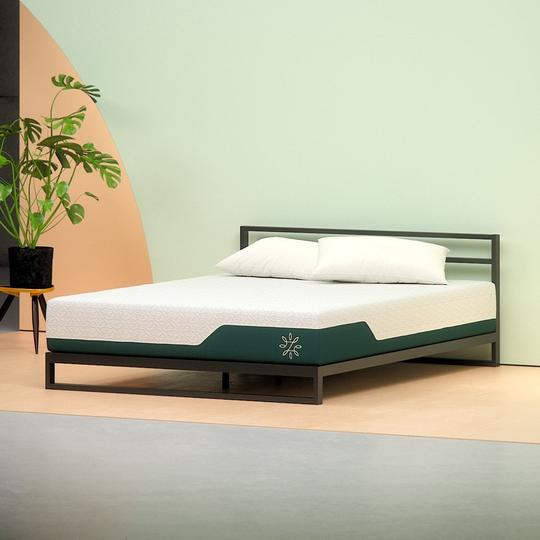
The comfort layer is comprised of 2.75 inches of gel memory foam and one inch of “Comfort” polyfoam that relieve pain and pressure in many key areas on your body, such as your shoulders, lower back, and neck. This mattress is a great choice for people suffering from back pain and similar problems since it alleviates one of the main hurdles in their day-to-day life: the difficulty of falling asleep and getting a good rest. The firmness levels correspond to the “Medium” variation of most hybrid mattresses, making this an ideal choice for people under 230 pounds. The “iCoil” support core is comprised of pocketed springs that enable healthy airflow and improve the quality of rest while allowing the user to sleep cool even during hot summer afternoon naps. The mattress doesn’t get saggy and misshapen thanks to the polyfoam layers around the spring core, ensuring the extended performance of this mattress for years to come.
Layla Copper-Infused Mattress
When you think about soft materials and comfort, the word “copper” very rarely springs to mind. The closest you normally come to contact with copper is in the micro-thin wires of a heated mattress pad. However, this mattress sports copper-infused memory layers that help the material closely conform to your body and relieve pain in important areas. It is one of the best mattresses for back pain. One of the biggest selling points is the unique approach to the firmness that Layla mattress has taken to help sleepers of different body shapes – you have two firmness options that you access by simply flipping the mattress over. One side is referred to as Medium with a firmness of around 4 on the 1-10 scale. The other side is referred to as Firm, and clocks in at around 7.5 on the firmness scale.

Copper is heat-conductive, which gives the mattress the ability to draw body heat away from the surface, helping the sleeper stay cool. The copper infusion can even promote stronger circulation, which is a health benefit that not many mattresses can claim to bring. The softer side of the mattress has a layer of soft polyfoam to provide extra cushioning and comfort. Because of the two different firmness options, the support layer has to be incredibly sturdy and dense to properly support the entire mattress. Layla have delivered, so the mattress stays in ideal shape for years and years and offers incredible support to sleepers of various body types and preferences. The motion isolation level is good enough to help couples avoid disturbing each other, as the mattress is also almost completely silent.
The Layla Copper-Infused Mattress comes with a whopping lifetime warranty since it’s made of the highest quality materials. You get a very generous 120-night sleep trial to test both sides of the mattress and find out if it’s to your liking. If you’re using Amazon Prime, you get free two-day shipping, so you don’t have to wait much to receive your mattress.
Nectar Memory Foam Mattress
If you’re someone who experiences shoulder pain or lower back pain, memory foam mattresses have probably been recommended before. They have some of the highest levels of pain and pressure relief, which makes them a popular choice for people with jobs that require a lot of physical labor. This Nectar mattress is no exception. It ranks at a solid 6 out of 10 on the firmness scale, which puts it in the Medium category, where mattresses are considered versatile enough for the highest number of different body shapes and sleeper preferences. This mattress can fit into any bed type you have in your bedroom, saving you the time you’d normally spend looking for a mattress that specifically fits your bed.

The comfort layer of most mattresses takes up around 25% of the whole mattress. Here it’s a bit thicker and uses both standard memory foam and gel memory foam to provide that extra cushioning that some sleepers need. The motion isolation and noise levels are also optimal for couples, even if both people involved are light sleepers. The double-layer support core features polyfoam construction that offers superior spinal support and pressure relief. Having proper spine alignment is the key to not only waking up well-rested but also avoiding a frightening amount of health issues that stem from bad posture and underwhelming back support. The cushioning is also enough to prevent a lot of otherwise common pressure points from forming, a common source of back pain and neck pain the next day.
This mattress comes with a generous lifetime warranty and a very convenient 180-night sleep trial, just in case you’re unsure of the product’s quality and would rather test it yourself or with your partner. Amazon Prime users get the extra benefit of free two-day shipping, while non-Prime users merely have to wait a few extra business days to get their mattress. Nectar’s customer support can also be an essential selling point since they’re very knowledgeable and helpful, on top of being incredibly polite and understanding.
Need to find a reliable bedwetting alarm for your kid or senior? Take a look at our reviews for the best bedwetting alarms currently sold on the market.
Nighttime bedwetting, also known as sleep enuresis, impacts not just adults—often older adults or those who have undergone recent surgeries—but is a common issue among children, especially around the 10-year mark. Classified under parasomnia, this group of conditions is defined by undesirable events occurring during sleep. In the U.S., around 5 million kids are affected by this condition, called nocturnal enuresis, with a slightly higher occurrence in boys over girls. However, for both sexes, it serves as a distressing and challenging situation for the children dealing with it and their family members. Beyond the immediate discomfort, this issue can severely disrupt sleep and adversely affect the child’s emotional health, sleep quality, and general growth.
Some of the most common causes of sleep enuresis include hormonal imbalance, constipation, diabetes, sleep apnea, small bladder, anxiety, genetics and old age. The good news is that this problem can be solved with the use of bedwetting alarms, which were proven to be the most efficient ’cure’ for bedwetting. These devices are programmed to alert the sleeper with noise, vibration or light when they sensor the very first drop of urine. Active use of these alarms will train the sleepers to wake up on their own when the time comes.
Since technology has come up with many gadgets that are making our lives easier, it has also brought us bedwetting alarms. While adults and elderly people are mature and conscious enough to deal with this problem correctly, we all know how children can be sensitive at that age, and that is why it is crucial to help them overcome bedwetting and the following feel of embarrassment. The great news is that most of the children respond well and want to use bedwetting alarms.
Counting Sheep’s Best 5 Bedwetting Alarms
- Nytone Bedwetting Alarm for Kids
- Malem Ultimate Bedwetting Alarm
- TheraPee
- DryBuddyEZ
- Chummie Premium
Nytone Bedwetting Alarm for Kids
Highlights:
- Warranty period – 1 year
- Emits strong vibrations, lights, and sounds
- Wearable
Our first pick is a classic among the bedwetting alarms since it was one of the first alarms sold and introduced to the market during the 1970s. Due to its long tradition, Nytone Bedwetting Alarm has gained the trust of many parents and children who use it nowadays. Tradition is an essential factor, especially when it comes to products for kids because parents are always looking for the most reliable and quality products for their children. However, parents are not the only ones who recognized Nytone’s quality, as many doctors also recommend this model because of the clinically proven treatments. In fact, Nyton was the first bedwetting alarm that undergone clinical trials to determine its effectiveness. According to the studies, this alarm significantly improves the bedwetting issues within the first two weeks of use, and sometimes it cures the problem entirely during that period.
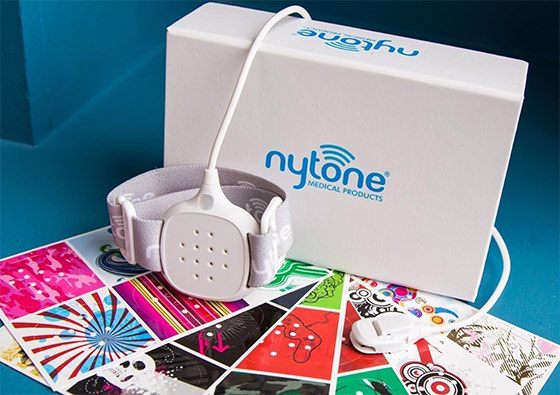
This alarm is designed to be wrapped around children’s upper arm with an adjustable, soft band, it weighs only 1.7 ounces, so it would not cause any pressure or discomfort while sleeping. To prevent any skin irritations the sensor has been coated, and it can be safely placed undergarments. You can attach the alarm to the garment with built-in clips for additional stability. Depending on the personal preferences, this alarm can be set on vibration, one of three different sounds or light signals, two Lithium batteries are included. For deep sleepers, they included loud noises and strong vibrations, which will awake the sleepers on time.
Many parents reach for medications to try solving the bedwetting issue faster, but the truth is that with the bedwetting alarm the results are long-lasting and the regular use will change those behavioral habits permanently. Another important thing is that bedwetting alarms are a completely natural solution, unlike chemically based medications.
Since, after all, this product is intended for kids, the designers tried to ‘cheer them up’ and make them love this product as much as their toys, by including a set of colorful stickers which will customize each alarm and make it more appropriate to their age.
The Nytone alarm is our top recommendation, the number of satisfied users and its long tradition guarantees the efficiency of this alarm which by the way has an affordable price tag.
Recommended for:
- Deep sleepers
- Children who prefer wearable bedwetting alarms
- Value seekers
Malem Ultimate Bedwetting Alarm
Highlights:
- Warranty period – 1 year
- Wearable
- Advanced features
This award-winning Malem bedwetting alarm is suitable for children and adults. This company has been on the market for around 30 years, and they started with just one bedwetting alarm, but now they produce more than 20 different models which can suit everyone’s needs. Doctors highly recommend their Ultimate Bedwetting Alarm, which features eight different sound tones including those loud enough for deep sleepers, vibrations, and light. For all those sleepers who like snoozing their alarms, this one will give you the option to turn off the alarm two times. Most bedwetting alarms do not have this option of a second turn-off. Sleepers can combine sound and vibrations or set them separately, but all settings have the following flashing light.
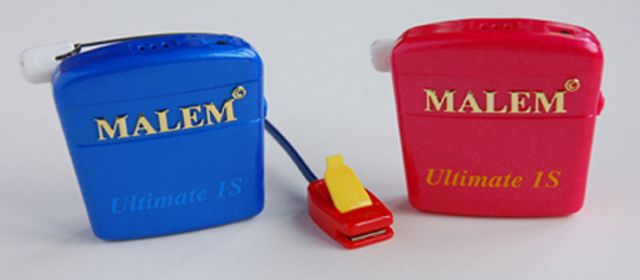
Their advanced sensor uses ‘Quick detect’ technology which will sense the first drop of moisture and rapidly alert the child. The clip-on sensor can easily be attached to the underwear, and the Secure Grip technology will keep it in place.
The millennials and Z generation will appreciate the free app for smartphones which provides all the information, answers, videos, tips, etc. to help them use their alarm correctly and achieve a positive outcome. This alarm is available in purple, blue and pink color, its dimensions are 2 x 2 x 0.8 inches, it weighs 0.8 ounces, and it comes with two AAA batteries.
Recommended for:
- Deep sleepers
- Sleepers who toss and turn
- Children who prefer wearable bedwetting alarms
TheraPee
Highlights:
- Warranty period – 1 year
- Comes with a software program
- Bell-and-pad bedwetting alarm
Our next model, the TheraPee alarm, is known as one of the most advanced bed wetting alarms on the market. Unlike other alarms that need to be wrapped or attached, this one comes with a pad that should be placed beneath the sleeper. This pad is so thin that the sleepers will barely notice or feel that something is beneath them, so the chances that this alarm will disrupt their sleep are minimal. Also, it can work even underneath the sheets, so it will not be in direct touch with the skin, while the alarm itself is connected to the pad with a thin cable and can be placed on a nightstand or nearby chair.
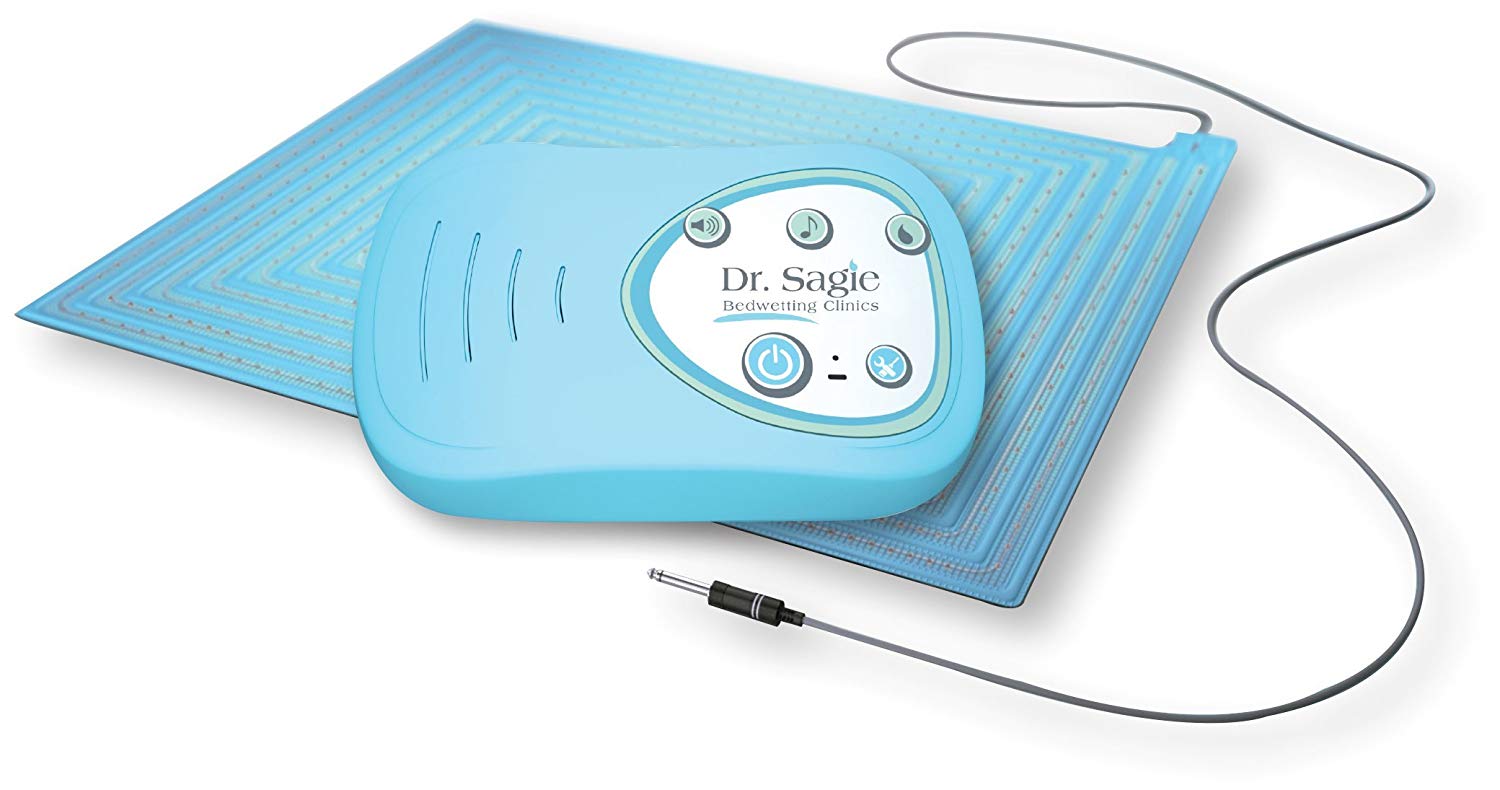
Once the parents purchase this alarm, they also receive licensed TheraPee online software program, which they can customize to fit their child’s needs and preferences. The special button serves to set the level of sensitivity so that there are no false alarms due to sweat or humidity. The only slight disadvantage of this alarm is that it offers only sound alarm, no vibrations or lights have been included. On the other hand, they offer ten different sounds with a wide range of sound volume from quiet to exceptionally loud.
With this alarm, children can relax and sleep without any objects or wires attached to them, and since it does not use a radio transmitter, there is no risk of radiation, which makes this bedwetting alarm probably the safest on the market. This high-end model has a high price – around 300$. It comes with four AA batteries and weighs 1.6 pounds.
Recommended for:
- Children and adults
- Children who feel comfortable sleeping on an alarm pad
- Deep Sleepers
DryBuddyEZ
Highlights:
- Warranty period – 1 year
- Wearable
- Emits vibrations and sound
As seen in our previous recommendation, enuresis alarms can cost a lot of money for such a small device, that is why we now represent you the cheaper alternative. The DryBuddyEZ bedwetting alarm can be found for less than 35$, which is an excellent price. Majority of people believes that the high price means high quality, but this product is one of those positive exceptions so let’s check its features.
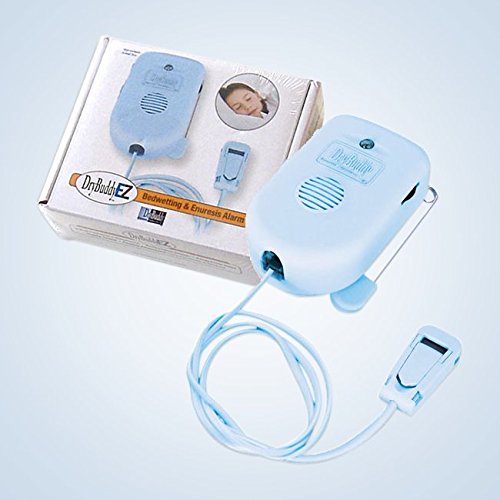
The alarm box is designed to be attachable to any part of clothing by using its safety pin or built-in plastic clip. The sensor cable is 34 inches long and the unique „Hold-tight“ sensor clip grips around 50% tighter than any other. If the clip is open, the alarm will not work, and when the clip is closed the alarm will work if it has wet cloth in it. When it comes to cleaning, the clip should be washed with warm soapy water and gently dried with a towel. It features sound and vibrations, and these modes can be set individually or combined. The loudness of the alarm is 90dB when it is placed 4 inches from the ear, or 87dB when around 8 inches from the ear, the continuous volume control will allow you to adjust the loudness from 0 to 90dB. Two AAA batteries are required, but not included.
This alarm is slightly heavier and bigger than other models, its dimensions are 4.7 x 3.9 x 1.6 inches, and it weighs 4.2 ounces (with batteries).
Recommended for:
- Deep sleepers
- Adults and children
- Children who prefer wearable bedwetting alarms
Chummie Premium
Highlights:
- Warranty period – 1 year
- Wearable
- Emits sounds, vibrations, and light
The Chummie Premium bedwetting alarm is one of the best bedwetting alarms for deep sleepers. Sensations such as bright lights, strong vibrations and volume control of different sounds are brought up to wake up the deepest sleepers rapidly. The two-step turn-off is also included for all those sleepers who need extra stimulation to wake up.
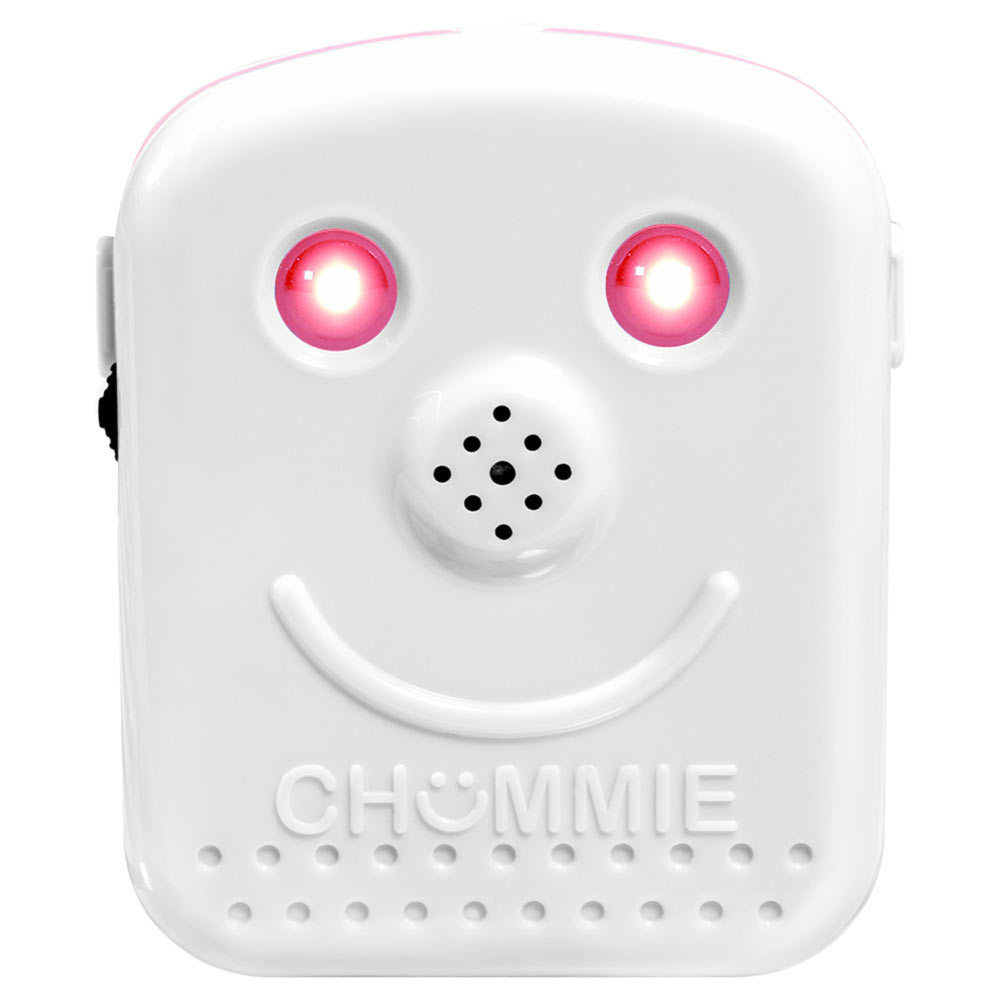
The Chummie sensors are made from silicone which is flexible and soft and features larger than the average area for urine detection. It will rapidly detect the very first drop and alert the sleeper for a quick reaction. This patented IntelliFlex pad-like sensor should be placed flat, outside of the underwear. Thanks to its rounded corners it will not poke the sleeper or cause the feeling of discomfort during the night. The sensor should be rinsed under warm water after each use but without any detergents or soap, and dried with a cloth. You can also shake it for 30 seconds, and after that, it will be ready for use again. Since there are no exposed metal parts, this sensor will never lack in their sensitivity or corrode and will perform well every night. The alarm box can be wrapped around the arm or clipped onto the shirt collar.
A free smartphone app is available to all users for any additional questions, tips, or support team contact. It is designed in three colors – green, blue and pink. The dimensions of this alarm are 2.5 x 2 x 0.5 inches, it weighs 6.4 ounces, and it works with two AAA batteries which are included.
Recommended for:
- Children who prefer wearable bedwetting alarms
- Deep sleepers
- Adults and children